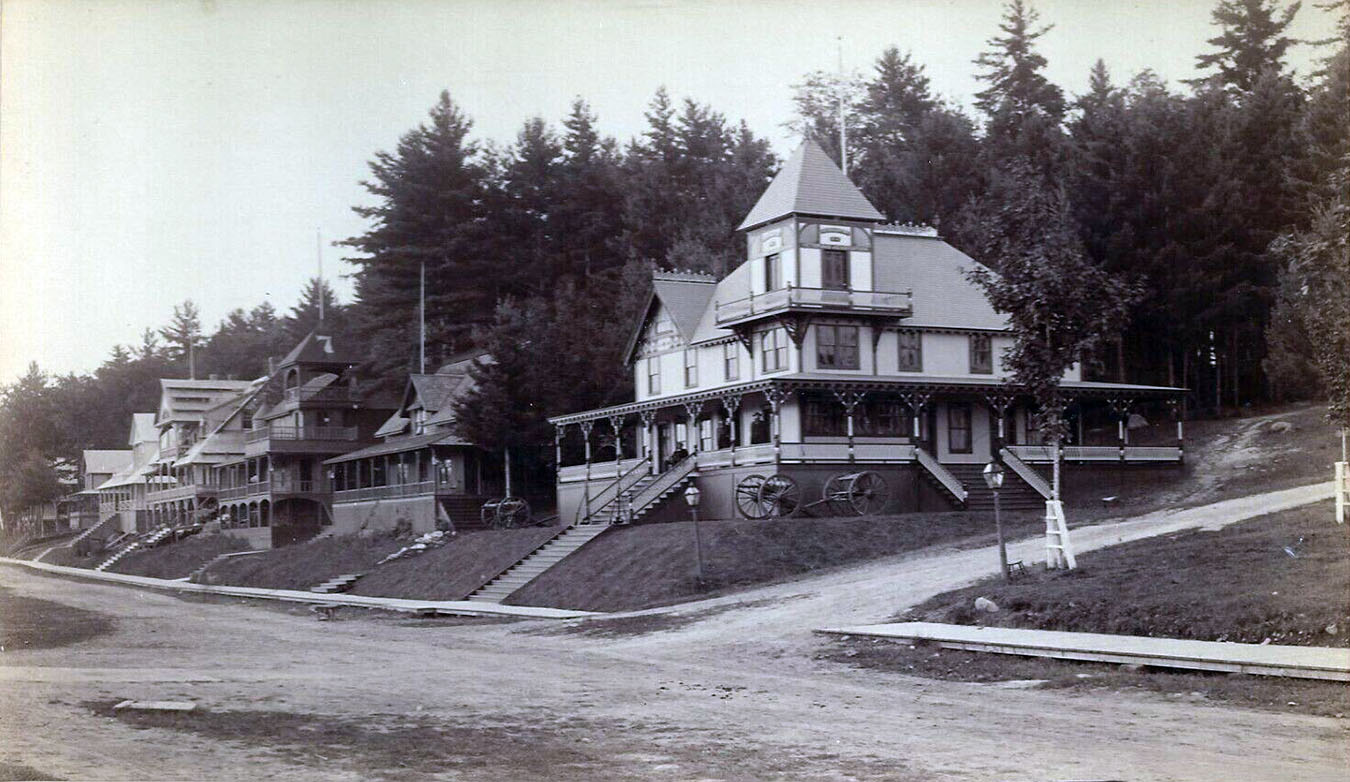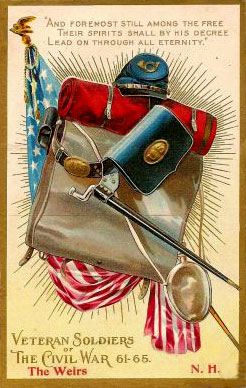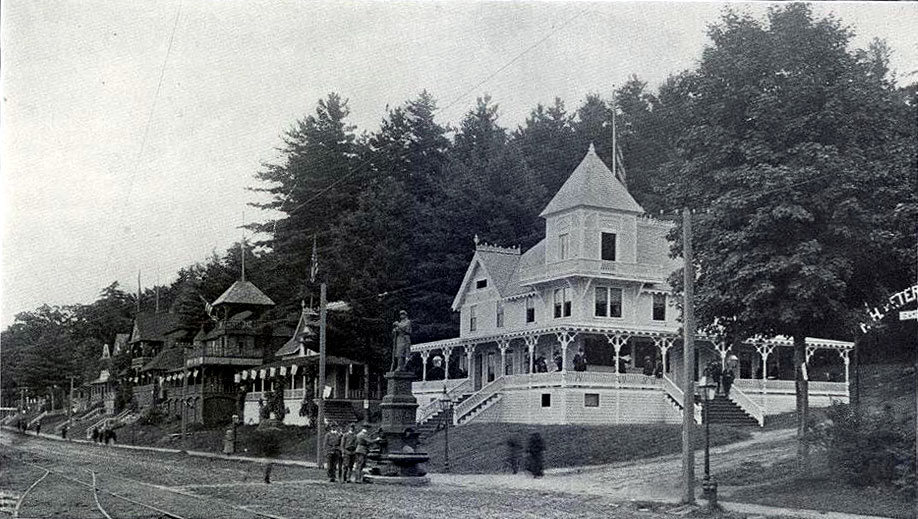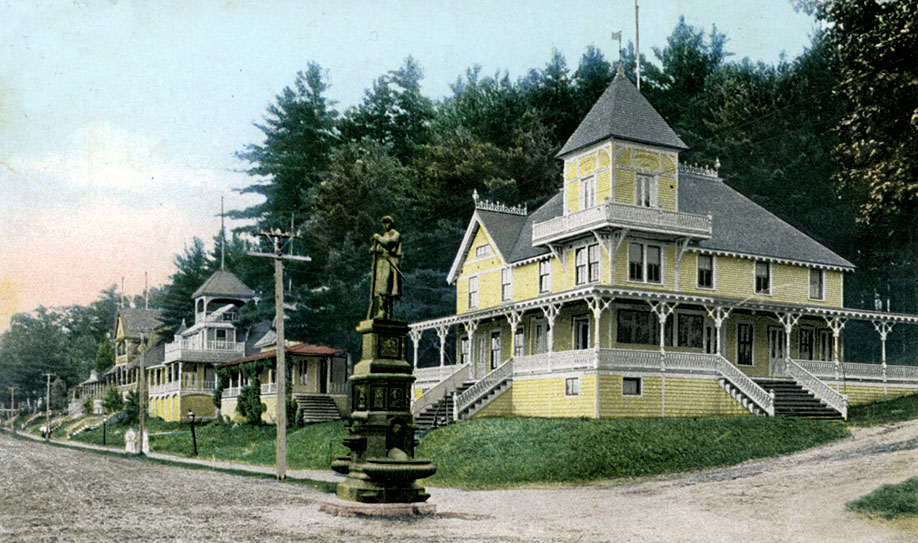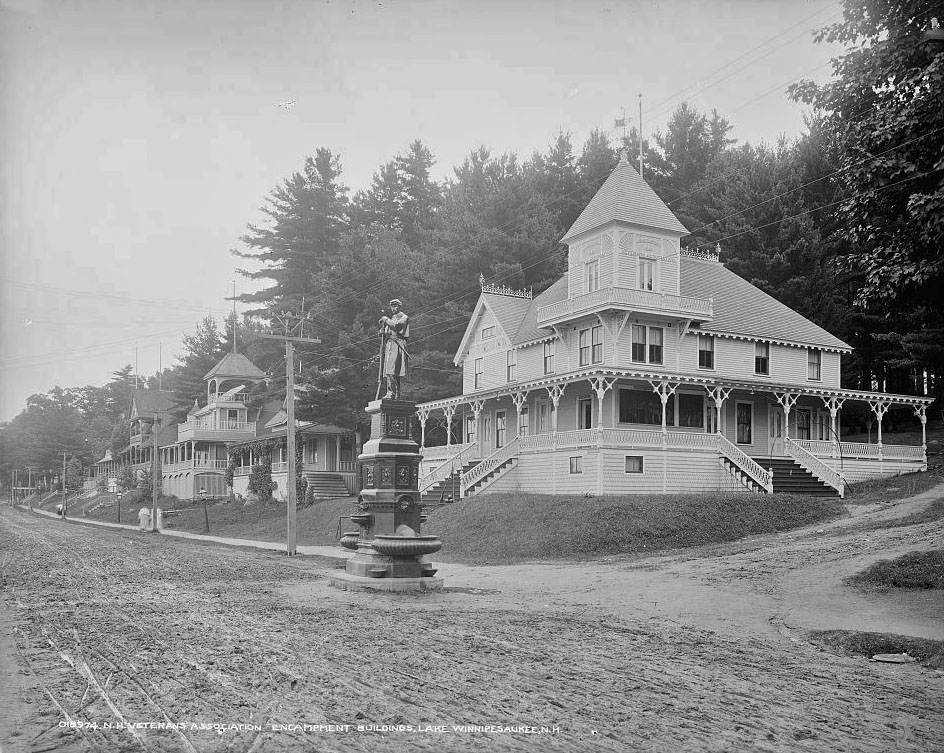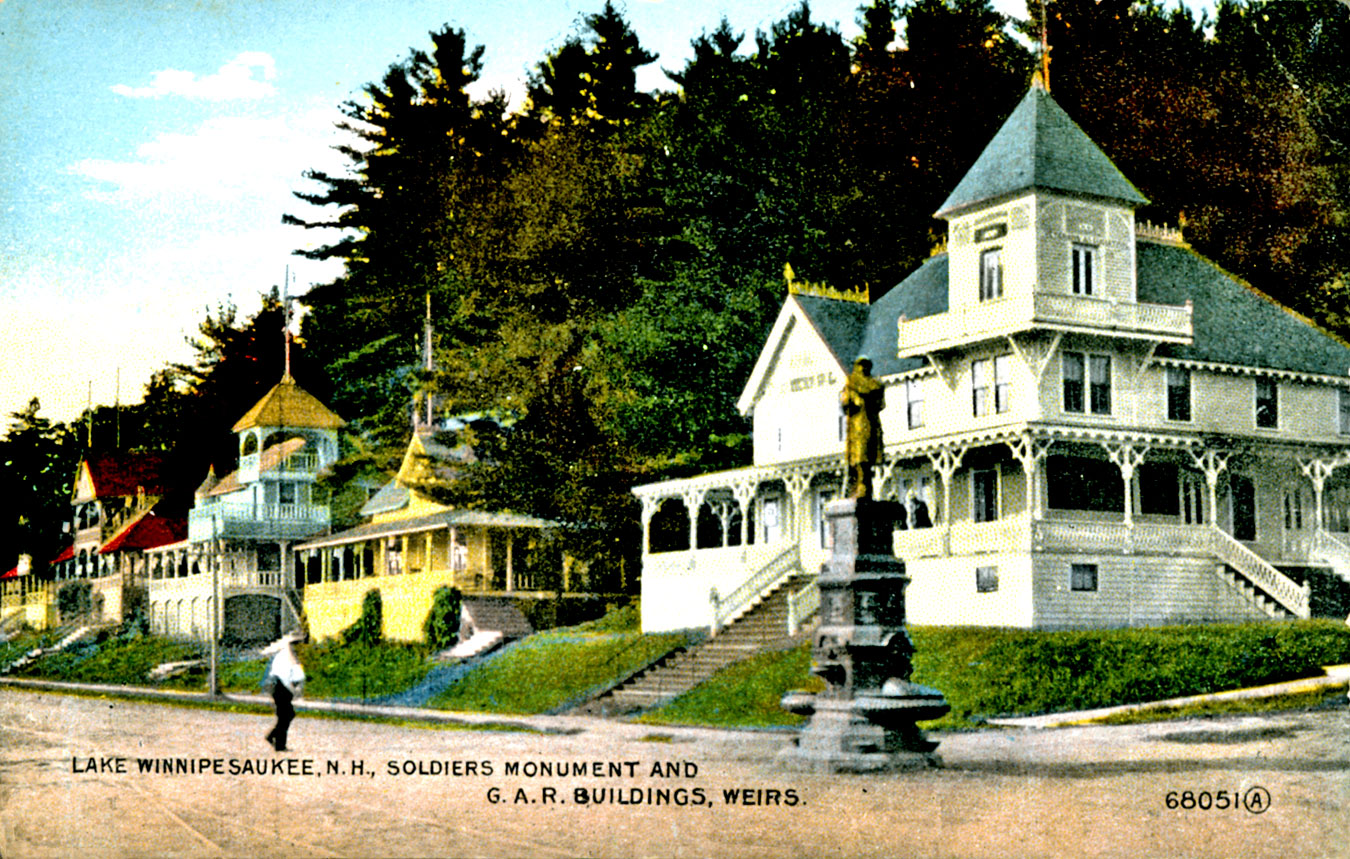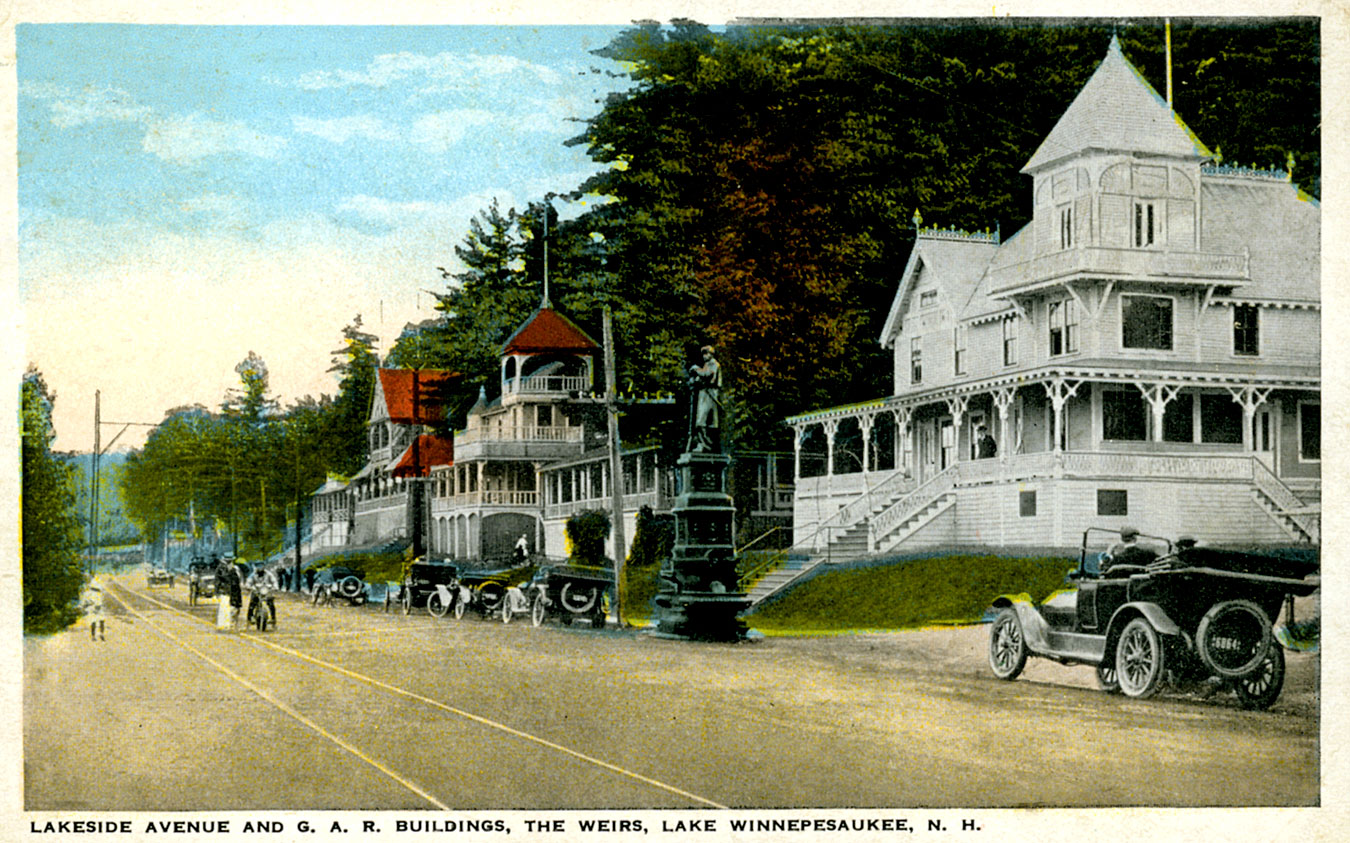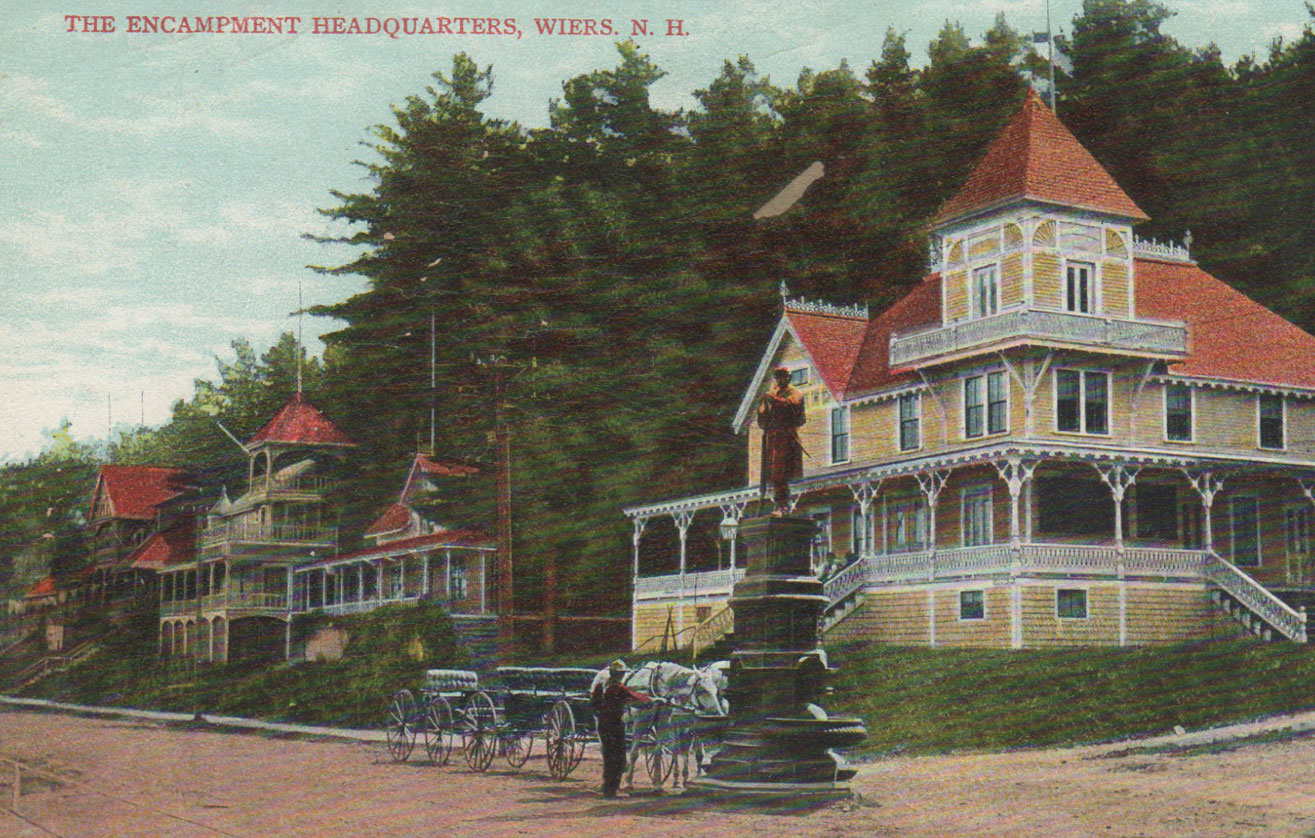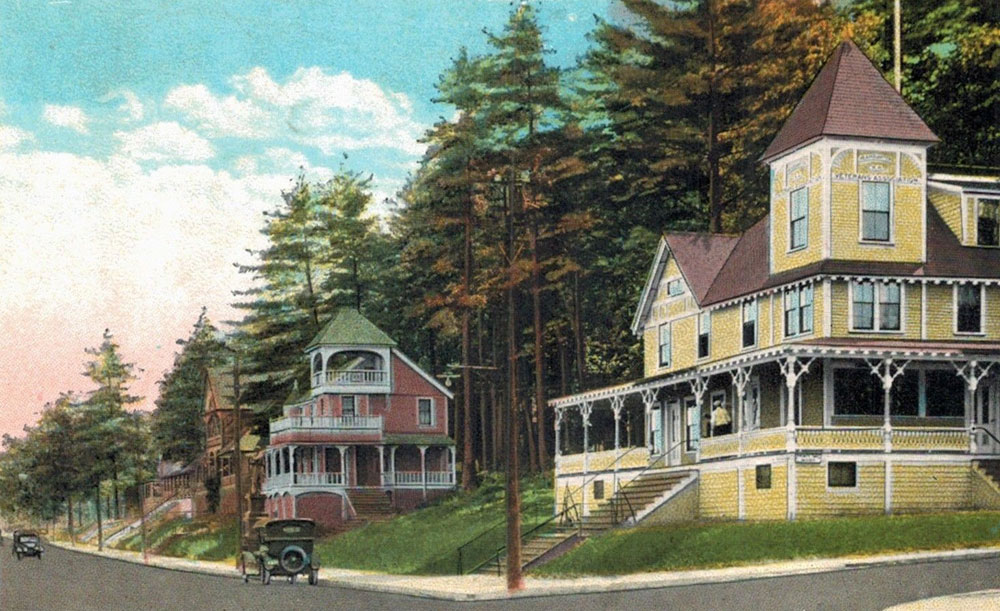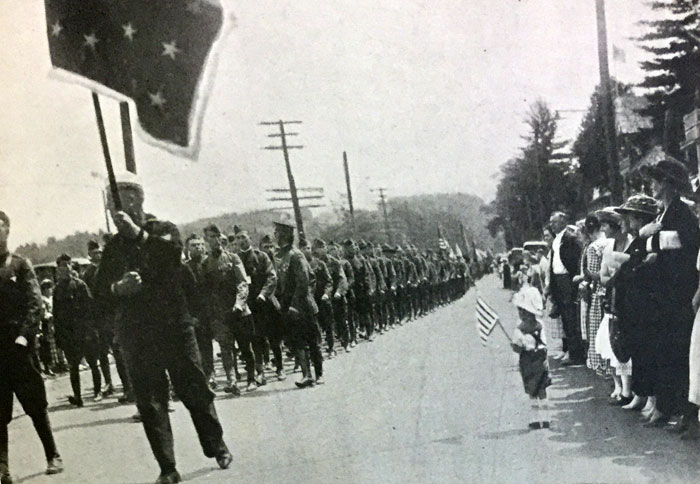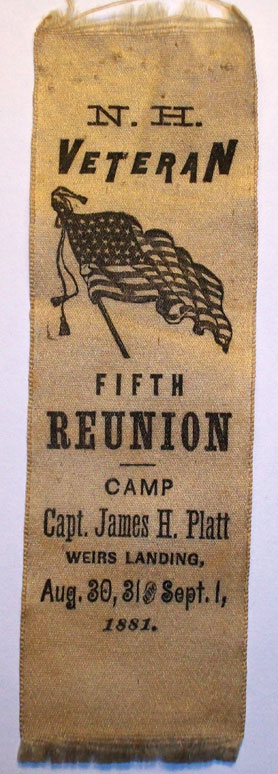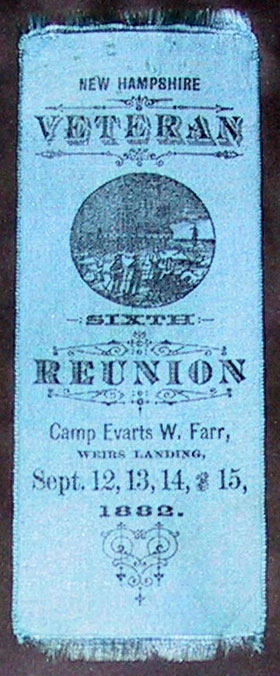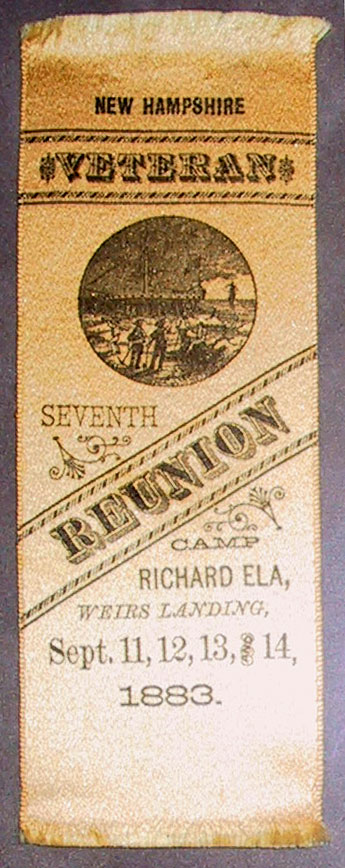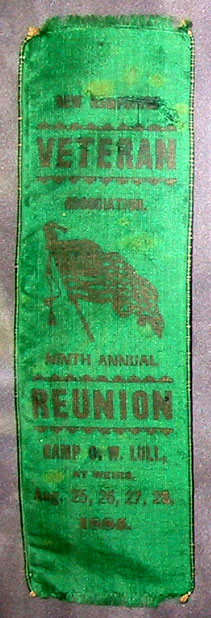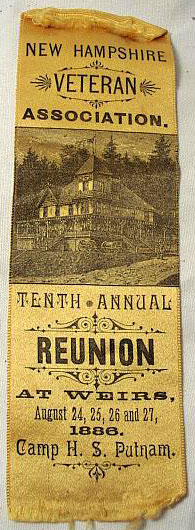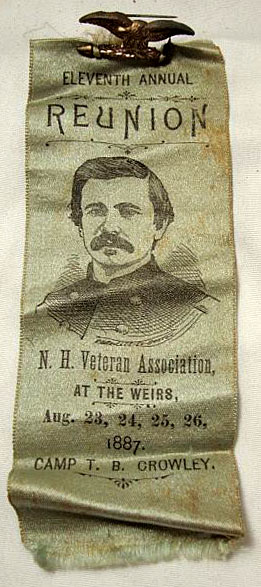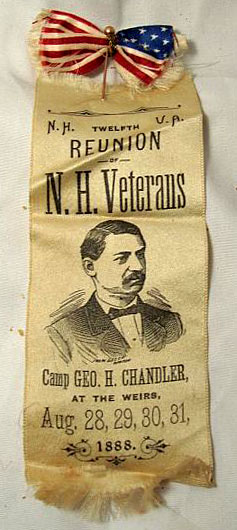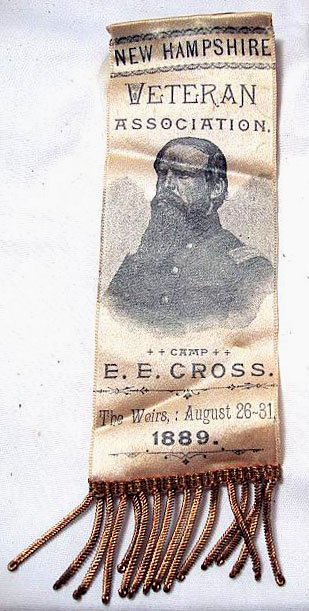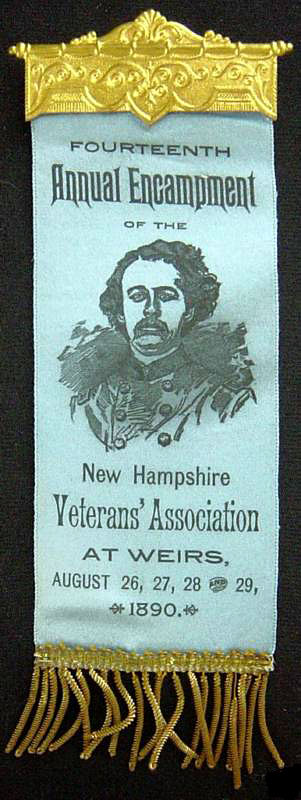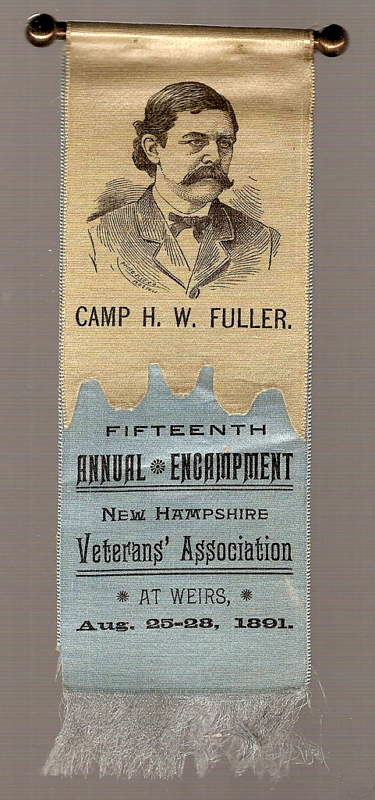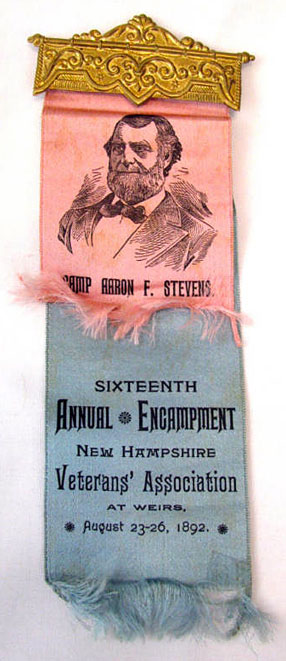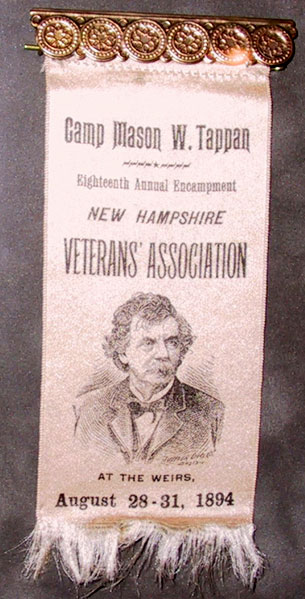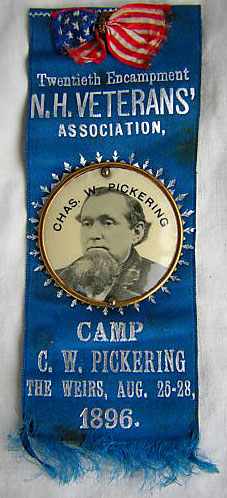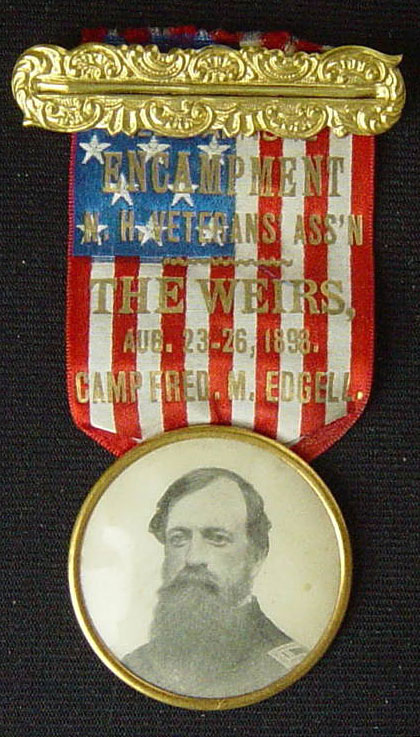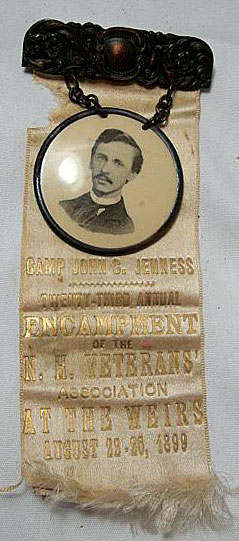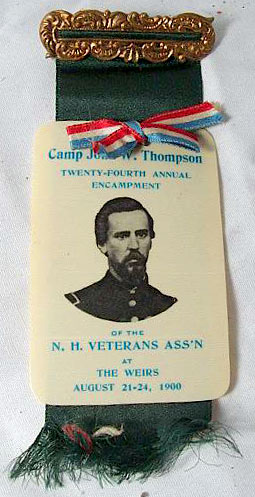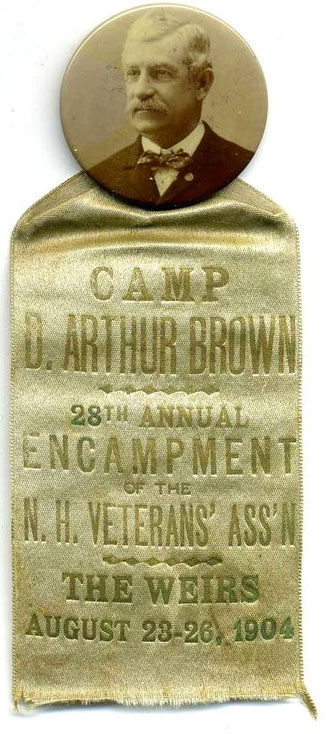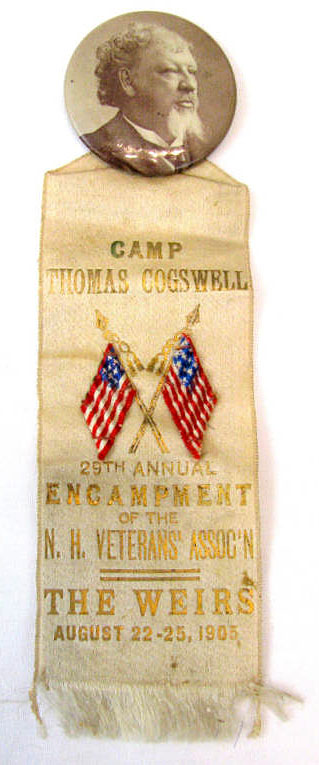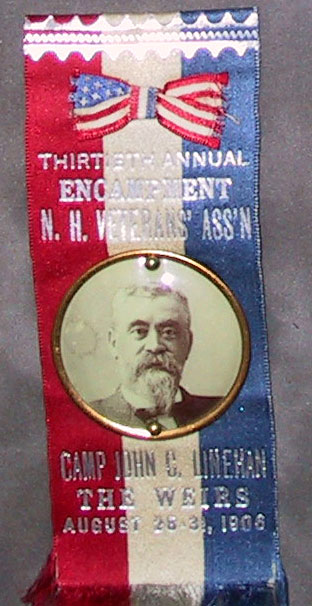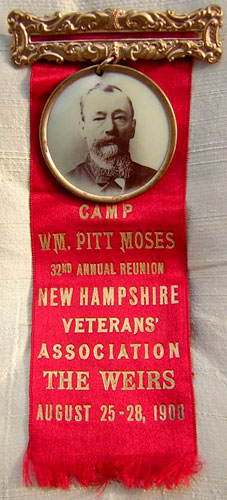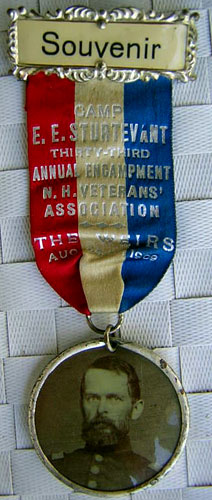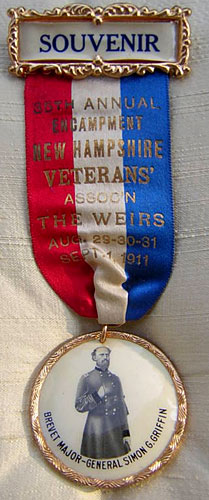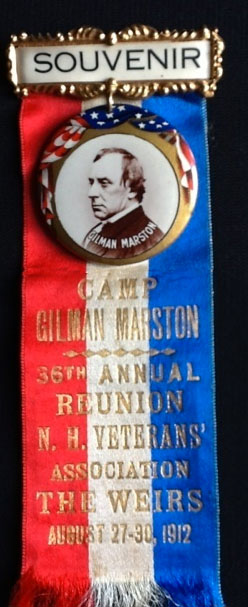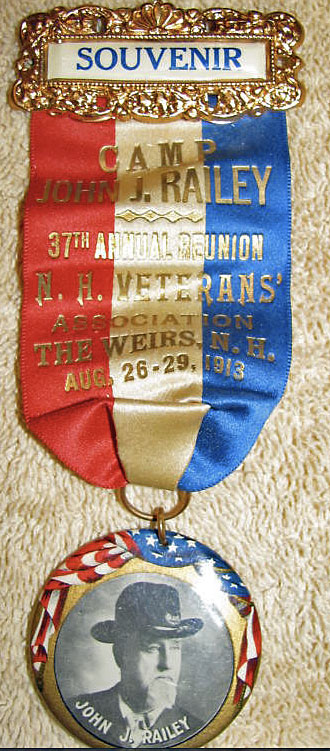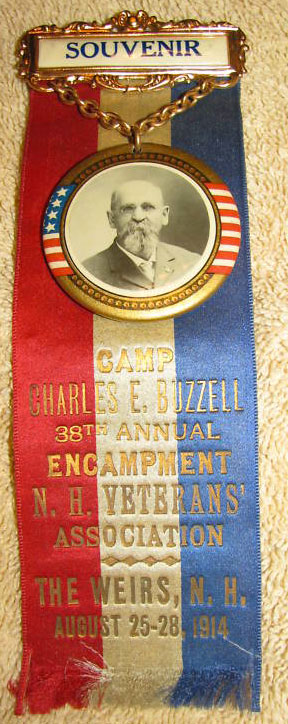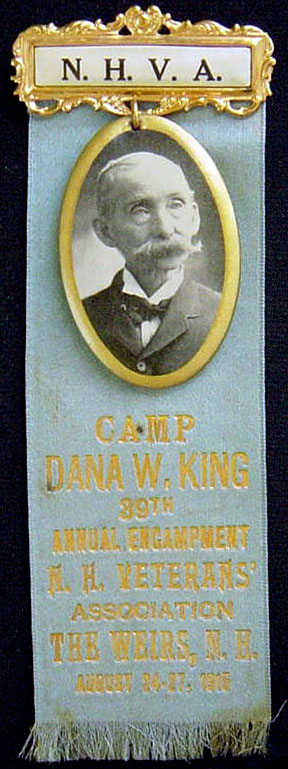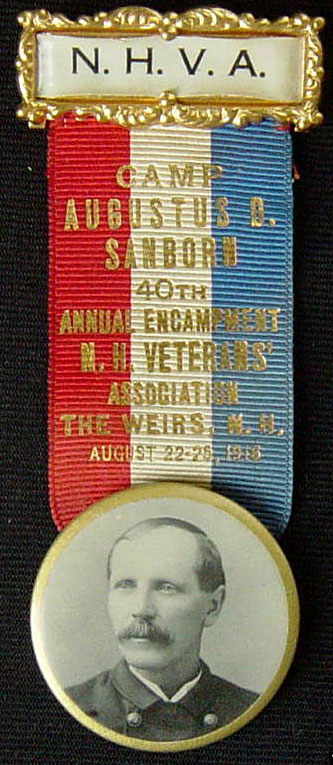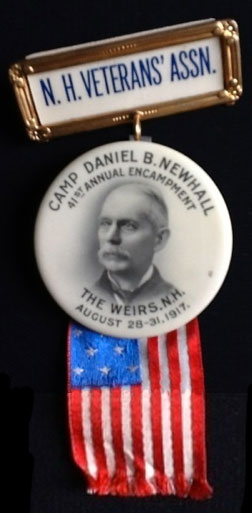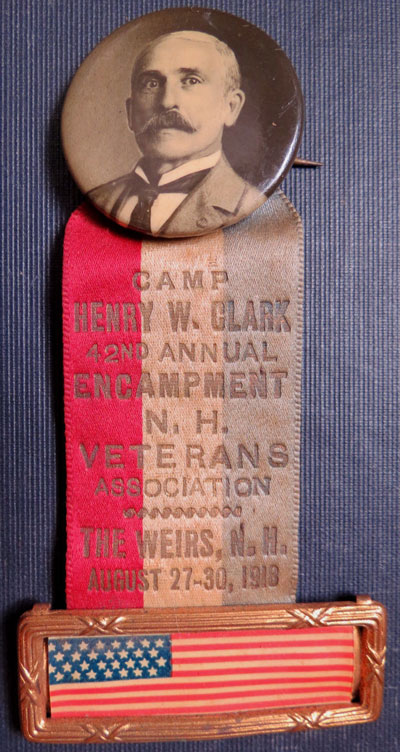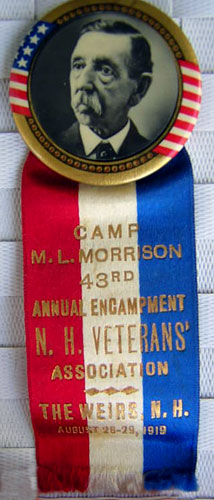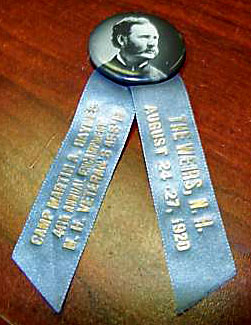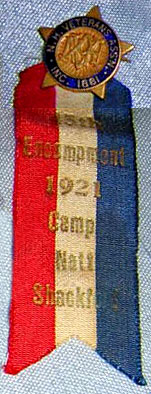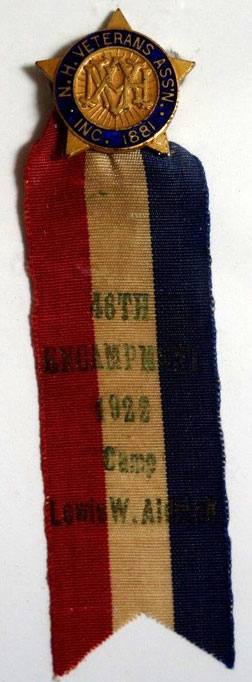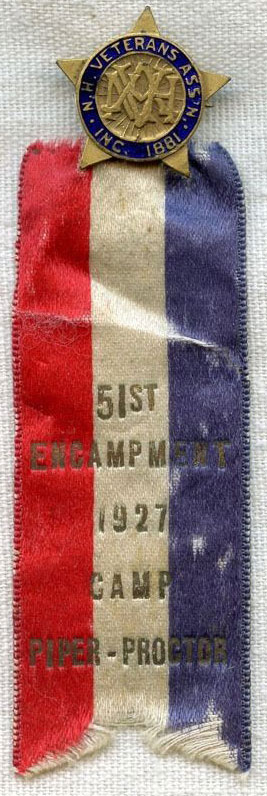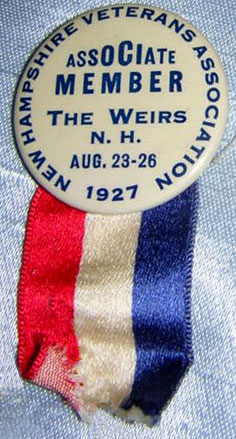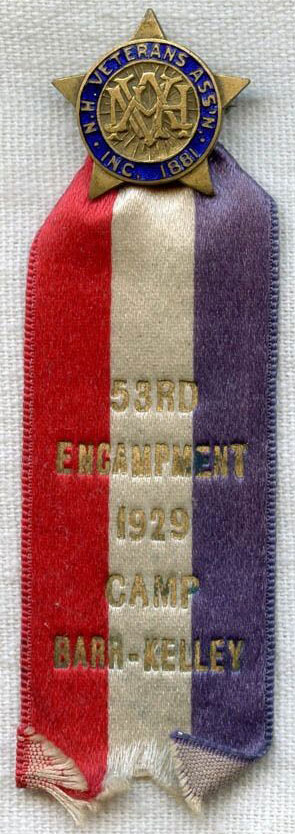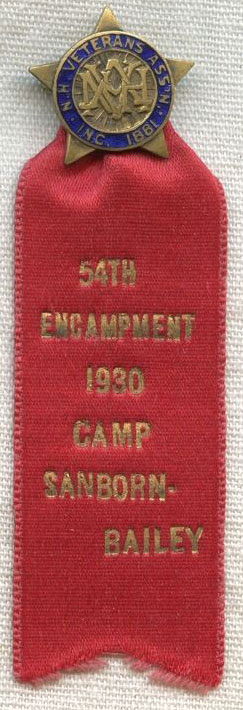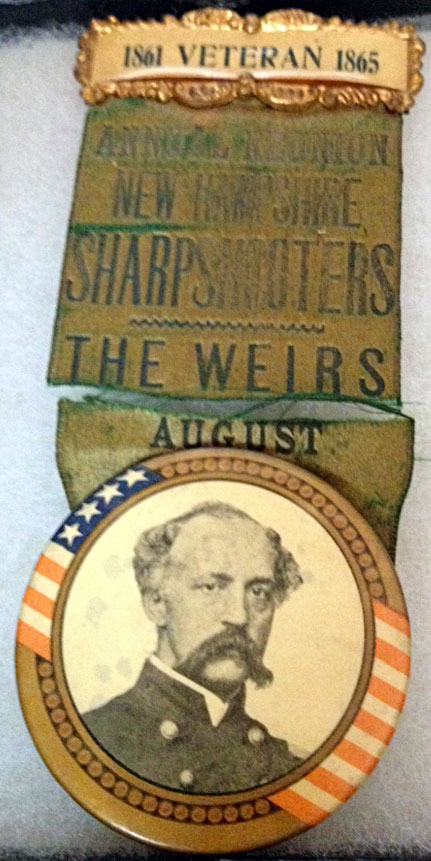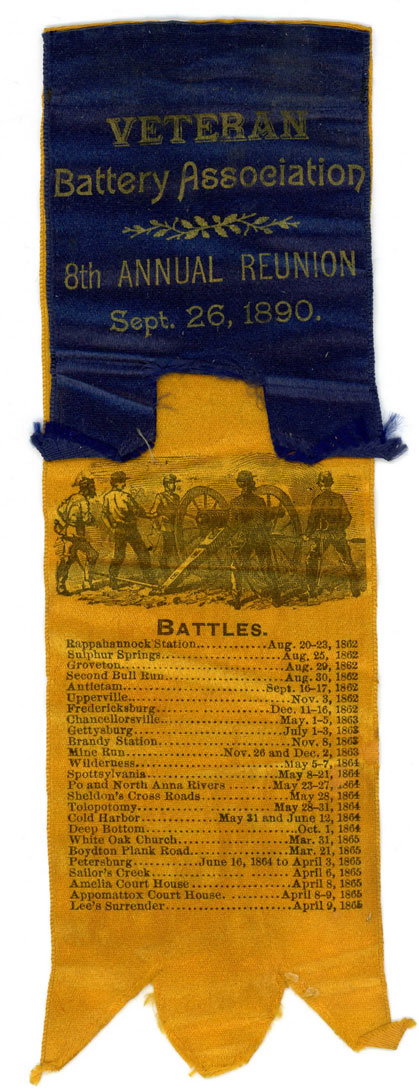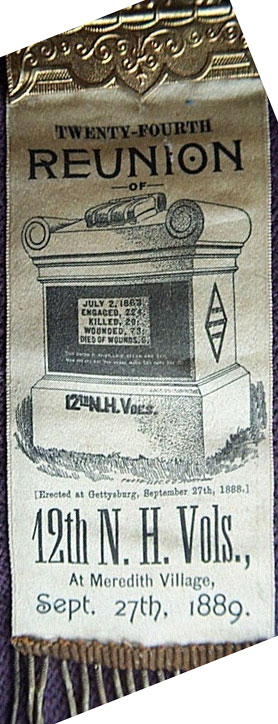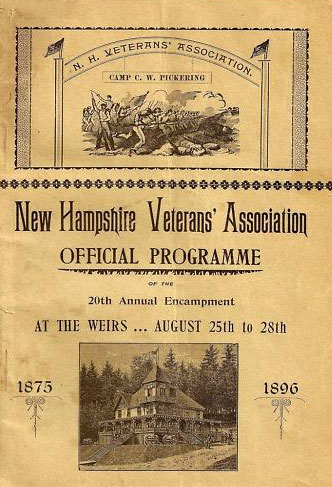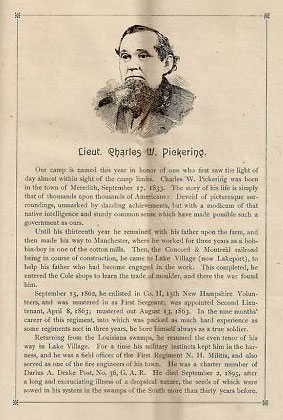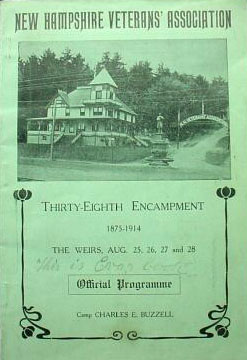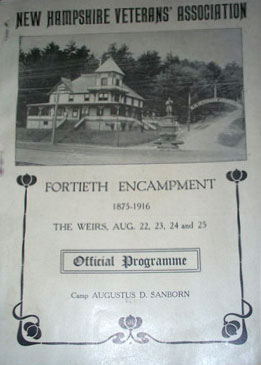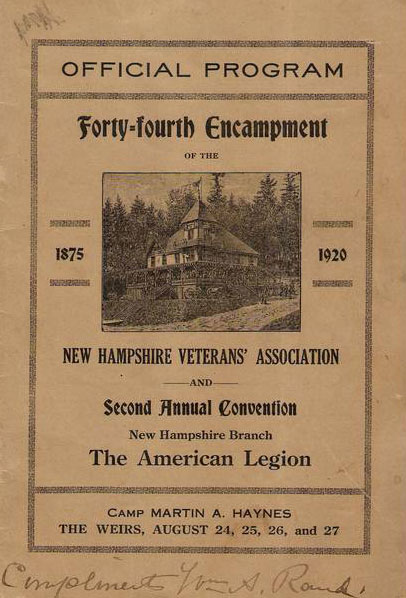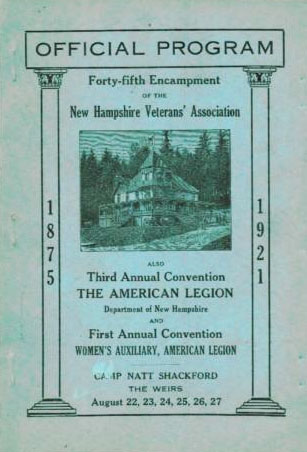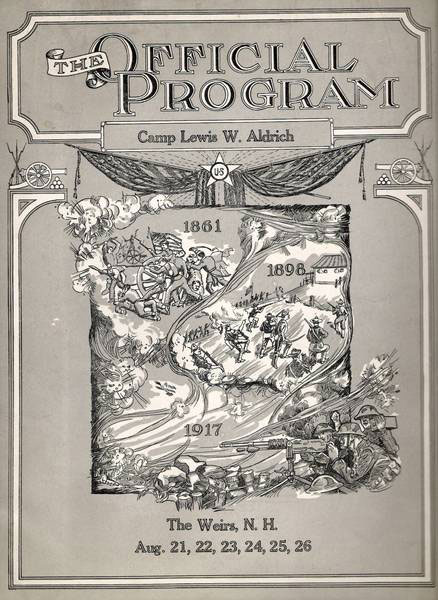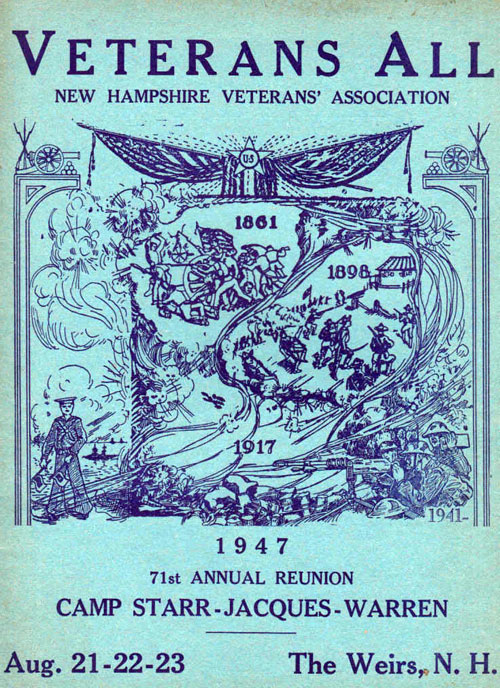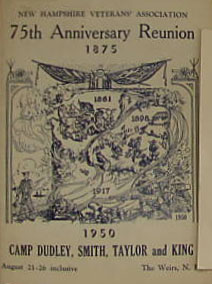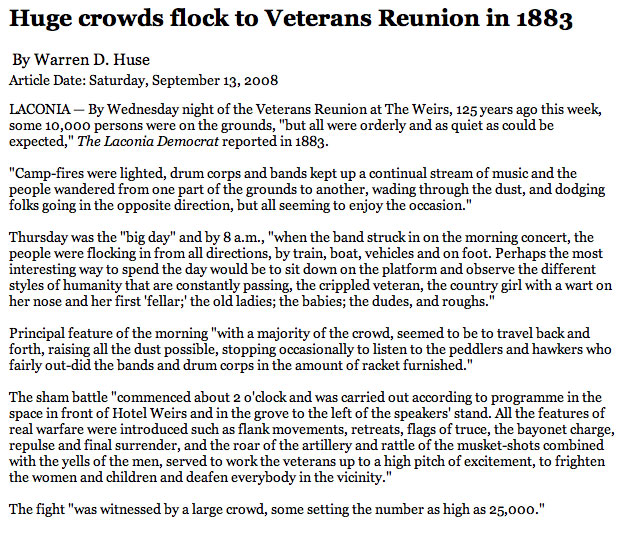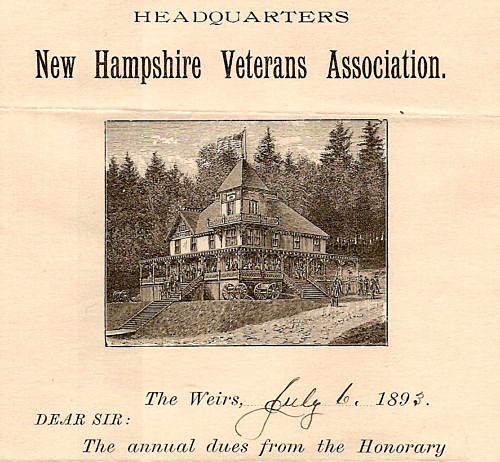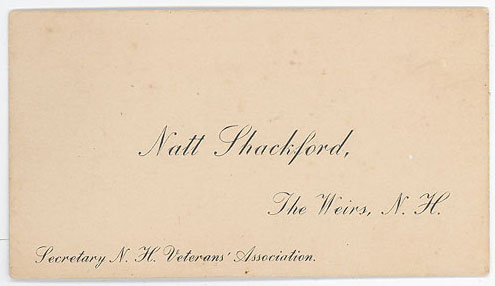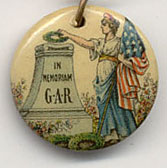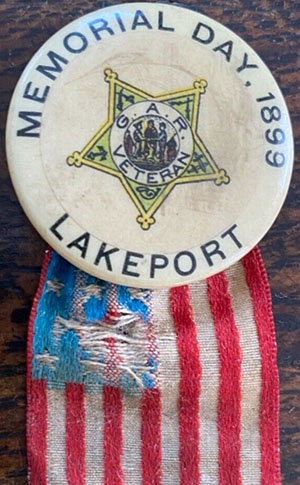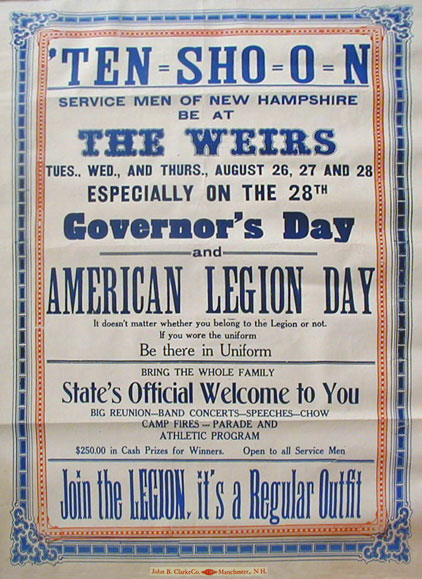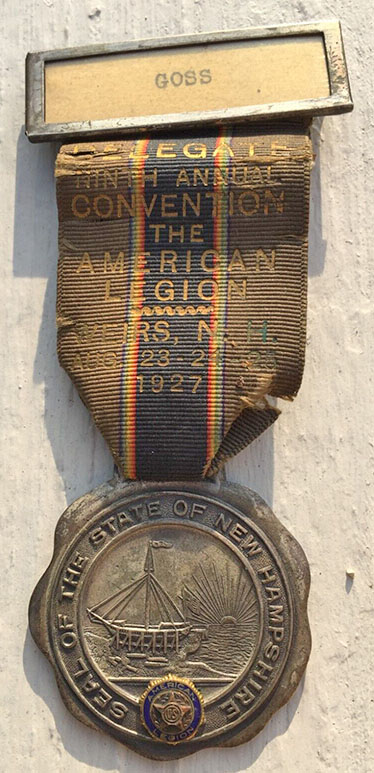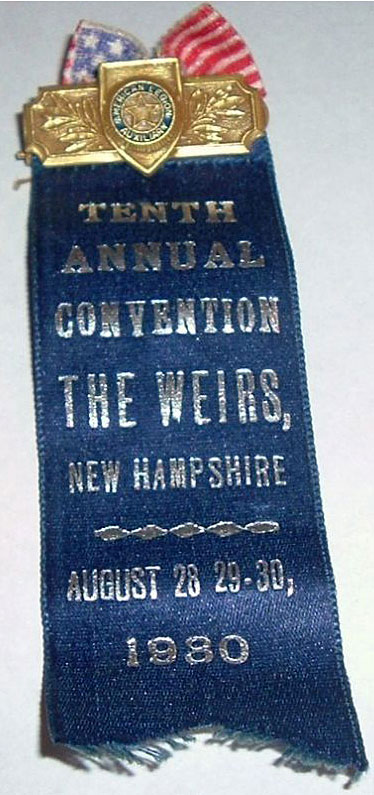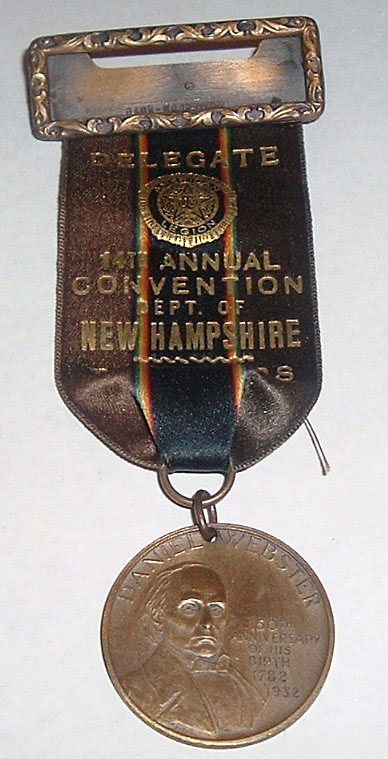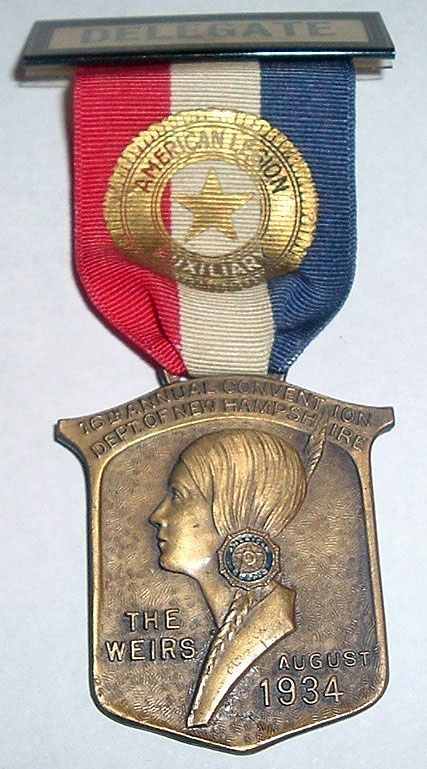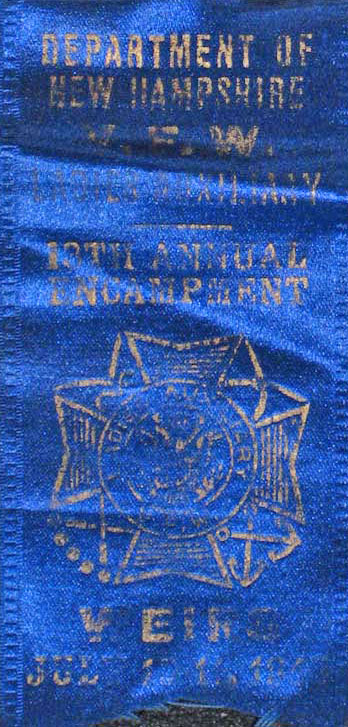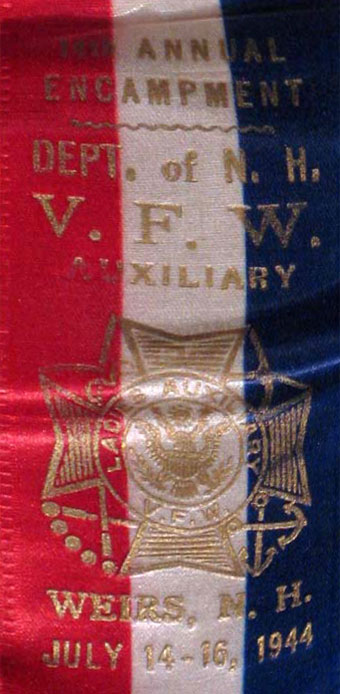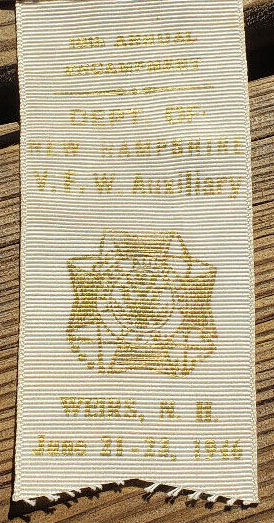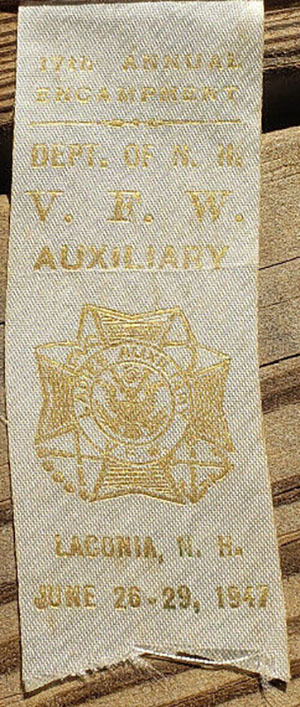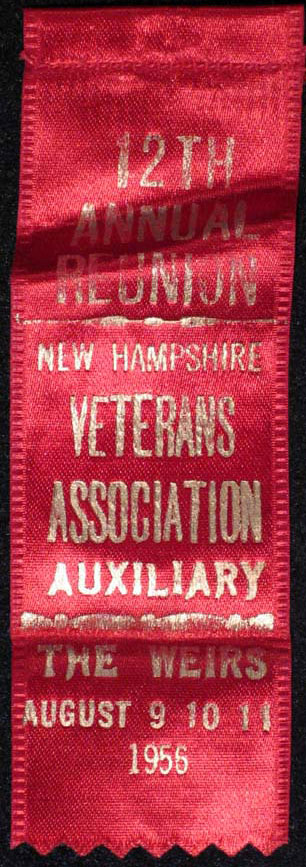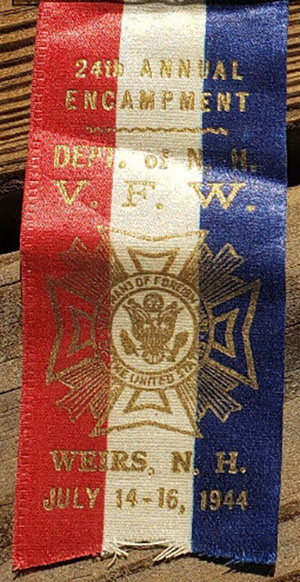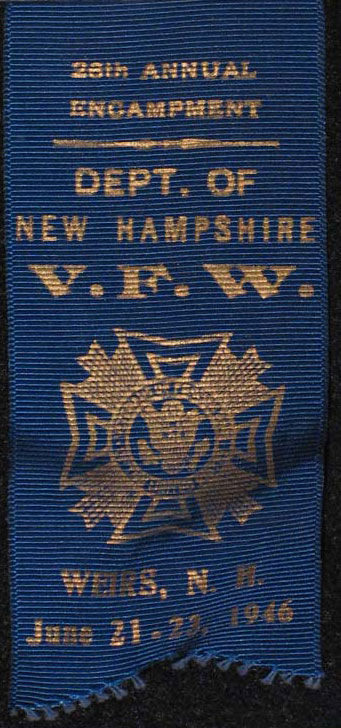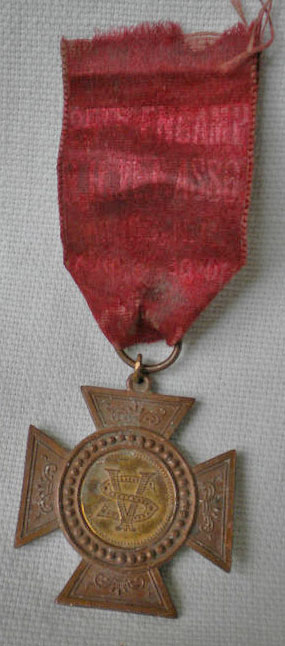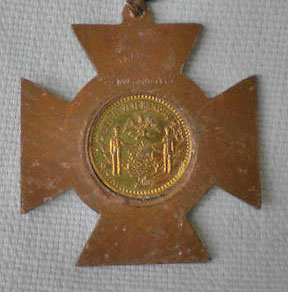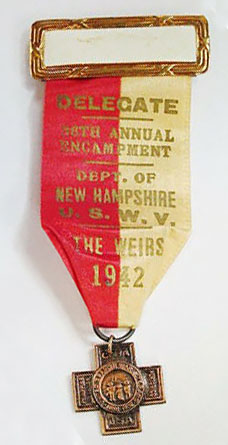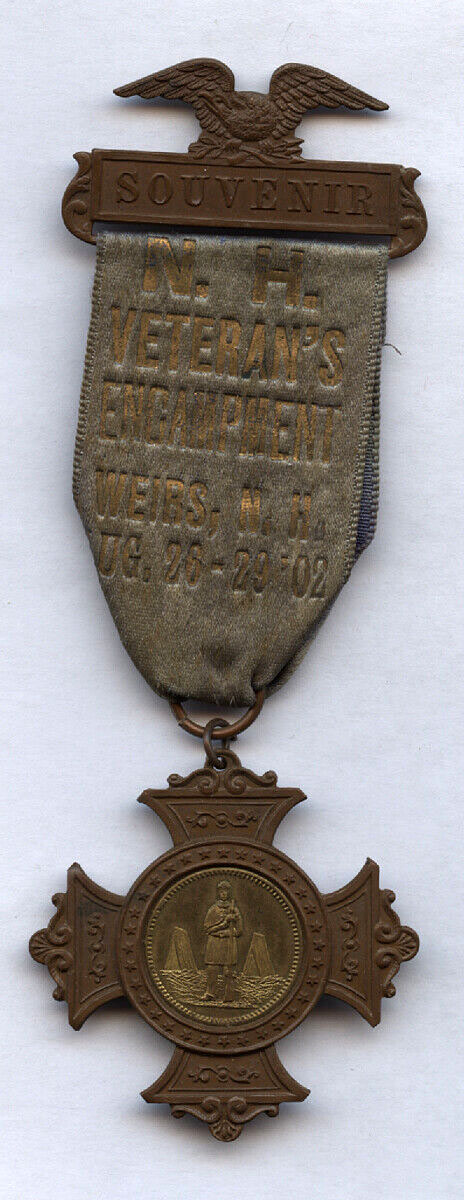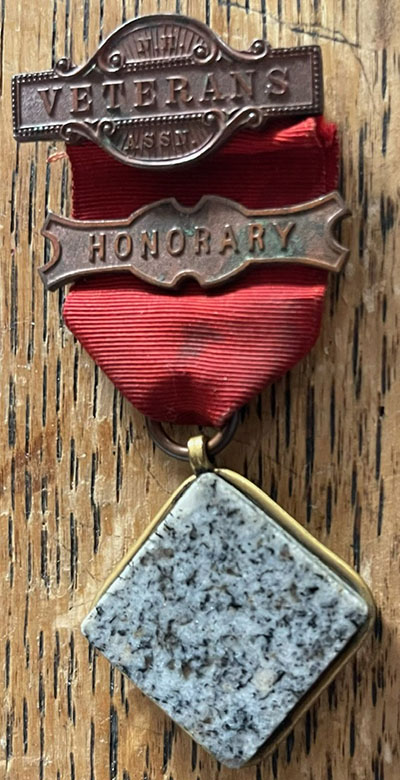New Hampshire Veterans Association History
Historical Time Line of the Association
1.) Tenting on the Old Campground (Tenting Tonight)
2.) Tramp! Tramp! Tramp! (The Prisoner’s Hope)
3.) Battle Cry of Freedom
4.) Marching Through Georgia
5.) Columbia The Gem of the Ocean
6.) Old Folks at Home (Swanee River)
7.) America (My Country ‘Tis of Thee) and
8.) When Johnny Comes Marching Home.
(Many of the above links are to the 97th Regimental String Band, highly recommended for their authentic versions of these songs.)
1880 Lowell building erected at the top of New Hampshire Ave. First floor was an open reception area, second floor was a dormitory with partitions. Original colors were straw with dark green and white trim and a green roof.
1881 The NHVA is incorporated by the State, an appropriation is made to erect 5 barracks ringing the top of the grove. A simple headquarters building next to the Lowell building serves as the temporary Association headquarters until completion of the permanent HQ building in 1885.
1882 Seating areas are placed in the hillside grove area. A speakers stand and pavilion are also built. The Sanborn Memorial is created and plans for the headquarters building and Dining pavilion are begun. Veterans of the Third Regiment Band and its successor, the Hilton Head Post Band, meet at the Weirs, and form an alumni group, the First Veteran Band Association of NH.
1883 The 5th Regiment building is constructed next to the Lowell building. The 1st Floor consisted of a large reception area, with the 2nd floor partitioned into sleeping area. The original color was off-white with dark green trim and had a brown roof. Individual Regiment associations begin to make plans to construct their own buildings on plots allocated to them.
A large arc sign bearing the name of the Association is erected on New Hampshire Avenue. The large sign is 41′ in length by 2 1/2′ in width. In the center of the arc, suspended by a couple of iron hooks, is a smaller sign, 18′ in length by 1 1/2′ in width, that would feature the name of the hero of each annual encampment.
1884 The 3rd Regiment & First Band building is constructed, the first NHVA building to be constructed on Lakeside Avenue. 3rd Regiment & 1st Band had an open area on the first floor, which could be divided into two rooms and an open 2nd floor which also could be divided. 1/3 of the building was used by the Band, the rest by the 3rd Regiment. The original colors were dark yellow with dark green trim.
1885 Headquarters Building and 7th Regiment buildings are completed on Lakeside Ave. Other smaller barracks may have been built to house the veterans.
The Headquarters Building had a large meeting room with offices to sides and rear on the 1st floor, a large meeting room with smaller rooms to the rear, and the 3rd floor housed a dormitory and storage. The original colors were: deep buff for the 1st floor, the 2nd & 3rd floors were lighter shades of buff, the trim was in different shades of brown and the roof was brown. The porch floor was brown, with the ceiling a light blue, the pillars and brackets were chrome yellow and red, the cresting dark red with old gold.
1886 The 2nd Regiment and Manchester House (Grand Army of the Republic) are built to the right and rear of the Lowell Building. The huge Dining Pavilion occupies the area in front and to the right of these structures out to Tower Street.
1887 The 16th Regiment Building is constructed on Veterans Ave. southern end. Next to the 16th is a new pavilion and smaller storage building. On Lakeside Ave., at the southern end, the 1st Cavalry built their Headquarters.
The 16th Regiment building had a large reception area with three smaller rooms on the first floor. The second floor had 2 large sleeping areas and two smaller rooms in the front towers. The original colors were bright yellow with greening blue and red trim. The roof was dark slate.
The Cavalry building had an open reception area with a nest of three fireplaces on the first floor. The second and third floors were dormitories. The original colors were two shades of blue trimmed in yellow – cavalry uniform. The roof had a light and dark slate checkerboard pattern.
1888 The 9th and 11th Regiments work together to construct their building on Lakeside Ave. between the Cavalry and 7th Regiments building. On Veterans Ave, opposite the 16th Regiment, the 15th Regiment finishes their building.
The 9th and 11th Regiment building had two large reception areas that were separated by folding doors with fireplace on each end of the first floor. The second floor was divided into two section, subdivided into three rooms. The third floor was a dormitory. The gables were painted straw with vermilion trim, the main body of the building was a darker straw. The roof was dark slate
The 15th Regiment building’s first floor was divided into two areas. The second floor was divided into three rooms. The building was painted light orange with bright red trim. The roof was light slate and the basement was brown stone.
1889 One of the temporary barracks next to the 5th Regiment is converted to use by the 8th and 13th Regiments.
1891 On land below the 15th Regiment the National Veterans Association of NH constructed the largest and most detailed building. This group was made up of NH veterans who were not in the individual regiments raised in NH. The building was sometimes referred to as the tramps building.
1892 A map of the Weirs showing the location of many of the buildings is published in Boston by D.H. Hurd & Co. This map had several inaccuracies, but it was the best available at the time.
1893 Below the National Veterans Association building and above the Cavalry Headquarters, the 14th Regiment constructed their building. The road was now named Cavalry Avenue, and marked the southern boundary of the property.
1896 Berdan’s Sharpshooters and the Heavy Artillery Companies constructed the last of the large buildings. This building sat at the western boundary of the property in an area with the state barracks. This seems to be the last of the large buildings constructed.
This construction period is sometimes referred to as the High Victorian period. Most of the buildings were very colorful with ornate details. Sometimes called the Queen Anne Camp Style, using a “balloon” construction style with sweeping roof lines and wrap around porches, they were and are beautiful to behold. Many of the buildings boasted running water and sewer, long before other “camps” in the area. Most featured large open areas on the first floors with fireplaces and water closets. The second and third floors would consist of dormitory style sleep areas which could, in some cases, be broken up into smaller more private areas with partitions.
The front buildings were repainted during this time using surplus military paint, hence the various shades of gray, blue gray and off-white.
Over the years, more buildings were taken down due to their poor condition, than were lost to fire. Only four buildings burned. They were the Third Regiment (1924), 8th&13th Regiments (1950s), Artillery/Sharpshooters (1992), and 16th Regiment (1995).
The 1990’s harkened the newest efforts to save this distinct piece of NH’s cultural history. Structural repairs – foundations, roofs, windows, upgraded electrical wiring, plumbing, and grounds work. Cosmetic improvements of painting and landscaping are ongoing. What has been accomplished may not show outwardly, but lays in the foundation of a long term plan to maintain the NHVA’s holdings for future generations of veterans and the citizens of New Hampshire.
One of the two cannons on the lawn of the NHVA headquarters, on October 6, 2007. One cannon is placed on each side of the HQ building. The cannons were manufactured by the Ames foundry and cast in 1847. Initially, the cannons were kept in a shed at the rear of the HQ and “trotted out at Reunion week only.” But in 1933, the cannons were “polished, moved down in front of the headquarters, and placed on cement foundations for permanent display.” The current practice is for the cannons to be displayed during the summer, from mid-May through mid-September, and to be placed in storage the remainder of the year.
Since 2000, this cannon, always on the right side of the HQ building, has been fired annually on the July 4th holiday, and during the Association’s yearly August gathering. According to Fred Merrill, the official historian of the NHVA, the cannon shot six-pound cannon balls. (This likely identifies it as an M1841 six-pounder field gun.) Merrill stated that during the Civil War, the cannon would typically be loaded with three pounds of black powder to shoot its six-pound ball. When it is fired during the present day, it is loaded with only one pound of Pyrodex (a safer, smokeless, black powder substitute), a wad of paper towels, and a small quantity of flour. The flour spreads out into the air following the firing, giving the impression of smoke. The parking spaces and street are cleared in front of the cannon prior to a firing, so there is no damage to vehicles from the burning paper wad.
Early annual gatherings, known as encampments, were named after individual New Hampshire veterans, all heroes of the Civil War. Both survivors and the fallen were named. For those individuals who survived the War, to be named was a tremendous honor. Souvenir ribbons, with the image of that year’s hero, were sold at each encampment. Over the years, these ribbons have become very desired collectibles.
Starting in the 1920’s, the ribbons became repetitive in design, with the honors shared between two or more heroes. These ribbons no longer had hero portraits, the hero’s first name, or the encampment dates on the ribbon. Perhaps this was due to declining enthusiasm and participation in the encampments. After all, the 1920’s were 60 years after the Civil War, and many Civil War veterans had passed away. As a May, 1923 article in the Granite Monthly stated, “The gathering had been losing interest of late because of the rapidly thinning ranks of the members. But now comes the American Legion, to carry on in the spirit of the old soldiers, and to continue the annual encampment at the Weirs, New Hampshire’s School of Patriotism.” The very few surviving Civil War veterans continued to die out until, in 1942, the Laconia Evening Citizen noted that “For the first time in reunion history, no Civil War veteran was present.” (The 1942 reunion featured a speech by NH Governor Robert O. Blood on August 29.)
Typically, the encampments were 4 day affairs, beginning on a Tuesday and ending on a Friday during the last week of August.
The portraits of ten of these heroes hang on the first floor of the NH State House. These heroes have bios on the NH Division of Historical Resources and are linked in the table below. One, Commodore George H. Perkins, even has his own statue at the State House.
CAMP | YEAR | DATES | ANNUAL |
|---|---|---|---|
| John G. (“J.G”) Foster | 1875 | October 12-14 | 1st |
| Phineas P. Bixby | 1878 | August 13-15 | 2nd |
| Nathaniel “Natt” Head | 1879 | August 25-27 | 3rd |
| James K. Lane | 1880 | Aug 31-Sept 2 | 4th |
| James H. Platt | 1881 | August 13-15 | 5th |
| Evarts W. Farr | 1882 | Sept 12-15 | 6th |
| Richard Ela | 1883 | Sept 11-14 | 7th |
| William P. Ainsworth | 1884 | August 26-29 | 8th |
| Oliver W. Lull | 1885 | August 25-28 | 9th |
| Haldimand S. Putnam | 1886 | August 24-27 | 10th |
| Timothy B. Crowley | 1887 | August 23-26 | 11th |
| George H. Chandler | 1888 | August 28-31 | 12th |
| Edward E. Cross | 1889 | August 26-31 | 13th |
| Louis Bell | 1890 | August 26-29 | 14th |
| Henry W. Fuller | 1891 | August 25-28 | 15th |
| Aaron F. Stevens | 1892 | August 23-26 | 16th |
| Orlando W. Keyes | 1893 | August 22-25 | 17th |
| Mason W. Tappan | 1894 | August 28-31 | 18th |
| Alexander Gardiner | 1895 | Sept 3-6 | 19th |
| Chas W. Pickering | 1896 | August 25-28 | 20th |
| William I. Brown | 1897 | Aug 31-Sept 3 | 21st |
| Frederick M. Edgell | 1898 | Aug 23-26 | 22nd |
| John C. Jenness | 1899 | Aug 22-25 | 23rd |
| John W. Thompson | 1900 | August 21-24 | 24th |
| Harriet P. Dame | 1901 | August 27-30 | 25th |
| Alvah S. Libbey | 1902 | August 26-29 | 26th |
| Ira C. Evans | 1903 | August 25-28 | 27th |
| D. Arthur Brown | 1904 | August 23-26 | 28th |
| Thomas Cogswell | 1905 | August 22-25 | 29th |
| John C. Linehan | 1906 | August 28-31 | 30th |
| George H. Perkins | 1907 | August 27-30 | 31st |
| William Pitt Moses | 1908 | August 25-28 | 32nd |
| Edward E. Sturtevant | 1909 | August 24-27 | 33rd |
| John L. Thompson | 1910 | August 23-26 | 34th |
| Simon G. Griffin | 1911 | Aug 29-Sept 1 | 35th |
| Gilman Marston | 1912 | August 27-30 | 36th |
| John J. Railey | 1913 | August 26-29 | 37th |
| Charles E. Buzzell | 1914 | August 25-28 | 38th |
| Dana W. King | 1915 | August 24-27 | 39th |
| Augustus D. Sanborn | 1916 | August 22-25 | 40th |
| Daniel B. Newhall | 1917 | August 28-31 | 41st |
| Henry W. Clark | 1918 | August 27-30 | 42nd |
| Mortier L. Morrison | 1919 | August 26-29 | 43rd |
| Martin A. Haynes | 1920 | August 24-27 | 44th |
| Natt Shackford | 1921 | August 23-26 | 45th |
| Lewis W. Aldrich | 1922 | August 21-26 | 46th |
| Joseph H. Killourhy | 1923 | August 13-16 | 47th |
| Joab N. Patterson | 1924 | August 26-29 | 48th |
| Edmund Tetley | 1925 | August 25-28 | 49th |
| Stickney-Roye | 1926 | August 24-27 | 50th |
| Piper-Proctor | 1927 | August 23-26 | 51st |
| Stevens-Worcester | 1928 | August 21-24 | 52nd |
| Barr-Kelley | 1929 | 53rd | |
| Sanborn-Bailey | 1930 | August 27-30 | 54th |
| W.H. Trickey | 1931 | 55th | |
| Clough-McCrillis | 1932 | 56th | |
| Stratton-Lovejoy | 1933 | 57th | |
| Estes-Doolittle | 1934 | 58th | |
| Murdock-Paul | 1935 | 59th | |
| Chase-Horne | 1936 | 60th | |
| Fish-Dunn | 1937 | 61st | |
| Nelson-Chase | 1938 | 62nd | |
| John D. Chase | 1939 | 63rd | |
| Willis-Cogswell-Boutwell | 1940 | 64th | |
| Bartlett-Lougee | 1941 | 65th | |
| Scovell-Staniels-Cheney | 1942 | August 29 | 66th |
| Sawyer-Trainor | 1943 | 67th | |
| Frank Knox | 1944 | 68th | |
| Butterfield-Amadon | 1945 | 69th | |
| Harry F. Shook | 1946 | 70th | |
| Starr-Jacques-Warren | 1947 | August 21-23 | 71st |
| Winant, Lang, Cantin | 1948 | 72nd | |
| Strong, McCarthy | 1949 | 73rd | |
| Dudley, Smith, Taylor & King | 1950 | August 21-26 | 74th |
| Woodbury, Rogers, Cushine | 1951 | 75th | |
| Turcotte, Bent, Millette | 1952 | 76th | |
| Lord, DuFort, Ellsworth | 1953 | 77th | |
| Arthur J. Kelley | 1954 | August 19-21 | 78th |
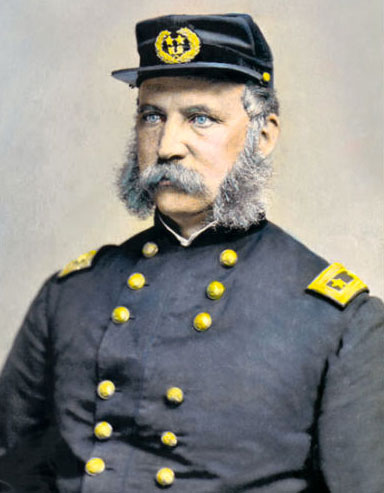
John G. Foster
(1st reunion-1875)
Foster, from Nashua, was a West Point graduate and an engineer. He served in many important battles during the War. After the War, he continued in the Army as an engineer, writing an important book about underwater demolition, perhaps inspired by his work on improvements to Boston harbor at the time. He was the first NH Civil War veteran to be honored by the NHVA and one of the most distinguished. Here’s a hand-tinted photo of General “J.G.” Foster, taken by the famous Civil War and Presidential photographer, Mathew Brady in 1863. Foster may have been the only veteran honored by the NHVA whose photo was taken by Brady, the best-known photographer of the 19th century.
Phineas P. Bixby
(2nd reunion-1878)
From Concord. Bixby served in the Sixth Regiment for nearly the entire duration of the war. He started as an Adjutant on November 30, 1861 and finished his service as a Colonel on September 17, 1865. During that time he spent two months in a Confederate prison, and three months recovering from severe battle wounds. His most important battles were the Second Battle of Bull Run and the Seige of Petersburg, VA. This latter battle became famous in military history for foreshadowing the trench warfare of World War I. At the Siege of Petersburg, the trench lines extended for over 30 miles, and ultimately led to the abandonment by General Robert E. Lee of the Confederate capital at Richmond.
Nathaniel "Natt" Head
(3rd reunion-1879)
From Hooksett. A successful business person and state legislator, was appointed Adjutant General of the State of New Hampshire in 1864, where he was responsible for organizing and maintaining the State’s records of NH regiments (wartime correspondence, biographical histories, and the like); and in honoring the living and memorializing the dead. Most importantly, he assisted veterans in their return to civilian life. Otis F.R. Waite, in his Civil War history, said of Head, “His constant and unwearied devotion to the “Boys in Blue” secured for him their highest respect and esteem and won for him the enduring title of “The Soldier’s Friend.”” Waite’s book, published in 1870, preceded Head’s greatest accomplishment. Head served as Governor of New Hampshire from June, 5 1879 – June 2, 1881. Click here to see a photo of General Head and to read Waite’s account. Post #72 of the NH Dept. of the GAR, in Fitzwilliam, was named after Head.
James K. Lane
(4th reunion-1880)
Corporal in Company G of the 11th Regiment. According to Leander Cogswell, in his history of the 11th regiment, Lane was “mortally wounded” on May 12, 1864 at the Battle of Spotsylvania Courthouse with the “colors” (NH state and/or US flags) in his hands, and died four days later. Some of the most savage fighting of the Civil War took place at Spotsylvania on May 12, 1864, in an exposed Confederate salient first called the “Mule Shoe” and later, after the massive casualties were counted, recalled as the “Bloody Angle”.
James H. Platt
(5th reunion-1881)
From Manchester, served in Company C of the Second Regiment. At the retreat from Bull Run, Platt exhorted his fellow soldiers, “Halt! boys, halt! – don’t run, a hundred men can take the battery!” His protestations were ignored. He had been promoted to Captain of Company E, when, in dense fog, “during the hottest of the fight”, he was killed with a bullet through the brain on May 16, 1864, during the Battle of Proctor’s Creek, part of the Bermuda Hundred Campaign. (This Platt should not be confused with the man of the same name who was Captain of Company B of the Fourth Regiment of the Vermont Volunteers, a Congressman from Virginia, and later, a Colorado businessman.)
Evarts W. Farr
(6th reunion-1882)
From Littleton. First Lieutenant in Second Regiment, where, in fighting at Williamsburg, VA, his right arm is shattered by a Minie Ball, and amputated. The Minie Ball was a large-caliber rifle bullet that was the Civil War’s most lethal weapon. However, Farr continued to fight. After recuperating, he joined the 11th Regiment, where as Major, he bravely led a charge at Fredericksburg. Farr died while serving NH as a US congressman in 1880. His bio can be read in Leander Cogswell’s history of the 11th regiment.
Richard Ela
(7th reunion-1883)
From Concord. In August, 1861, Ela enlisted as First Lieutenant of Company E of the Third Regiment. On June 1, 1862, he was promoted to Captain. He fought in several engagments including the Battle of James Island; the Assault on Morris Island; and the Battle of Fort Wagner. On August 13, 1863, he was appointed Commander of a corps of about 50-60 Sharpshooters, organized from “the 8% of officers and 2% of the rank and file who are know to be the best marksmen”, but the Sharpshooters did not see much action, and Ela returned to command of Company E. On May 13, 1864, while “gallantly leading his company up an incline to attack the enemy in its rear”, he was shot through the head at the Battle of Drury’s Bluff, near Richmond, VA. The night before, Ela foresaw his own death, saying “though I know this to be my last battle, my duty to my country shall be well done.”. Well-liked by his men, his Company “fought like devils to recover the body.”
William P. Ainsworth
(8th reunion-1884)
From Nashua. Captain, Company M of the First New England Cavalry. Ainsworth became Commander of the Second Batallion of the First Regiment Rhode Island Cavalry. The Second Batallion was comprised of all the troops from New Hampshire serving in the Rhode Island regiment. One week after the defeat of Union forces by Stonewall Jackson on May 23, 1862 at the Battle of Front Royal, the Second Batallion is sent to retake the town. In a May 30, surprise attack on Front Royal, the Second Batallion succeeds gloriously, but in the pursuit of retreating Confederate forces, Ainsworth dies at the head of his command, pierced by eight enemy balls.
Oliver W. Lull
(9th reunion-1885)
From Weare. Prior to the war, a Lieutenant of the Governor’s Horse Guards. A Lieutenant Colonel in the Eighth Regiment, he was a valued assistant to two Generals. Killed on May 27, 1863, while leading the charge storming the extensive Confederate earthwork fortifications at Port Hudson. The charge failed miserably. The Union army then began a long, 48-day seige, which ultimately led to the fort’s surrender. A detachment of the Governor’ s Horse Guards performed the military honors at Lull’s funeral. The Guards paraded at NH ceremonial functions from 1860-1865 before becoming defunct. Only half its members survived the Civil War. The remaining members could not pay for the Guard’s expenses for which the state of NH had never contributed a dime. The Horse Guards were revived in 2000 by Governor Jean Shaheen and now are a department of the NH Army National Guard. Click here for Lull’s bio in Otis F.R Waites book, NH in the Great Rebellion.
Haldimand S. Putnam
(10th reunion-1886)
From Cornish. A West Point graduate, Putnam began his service to the US military in 1857, when he was assigned to duty on the Western frontier. In 1861, shortly before the War was to begin, Putnam completed a special mission to deliver a secret message to Fort Pickens. Located in the Florida panhandle, Fort Pickens was one of the few Southern forts to remain in Union hands throughout the Civil War. After the War started, Putnam fought in the First Battle of Bull Run, then became Colonel of NH’s Seventh Regiment.
On July 18, 1863, during the Second Battle of Fort Wagner, Putnam was in charge of the 2nd Brigade, which consisted of the 7th NH, the 62nd and 67th Ohio, and the 100th New York. His brigade had taken the southeast bastion of the fort when, under heavy fire, Putnam was killed when a bullet blew off the back his head. This battle became famous as the first Civil War battle in which a regiment of African-American soldiers, many of them former slaves, had taken part. A 1989 Hollywood film, “Glory”, depicted the brave actions of this regiment, the 54th MA of the 1st Brigade, who had been in the vanguard of the attack on the fort.
Timothy B. Crowley
(11th reunion-1887)
From Nashua. Captain of the “famed Irish” Company B of the 10th Regiment, which he personally recruited. In the “gallant charge” at the Second Battle of Fair Oaks, on October 27, 1864, Crowley was severely injured in his thigh area, and barely escaped capture, having to crawl away to safety. For the rest of his life, he remained “a constant sufferer; a sufferer for his country, but no man ever heard him express regret for the service he had rendered the old flag…”. His bio and engraving from the 1887 reunion program are reproduced here.
His son, James B. Crowley, became the Mayor of Nashua during the WWI period. James Crowley played the hero’s son role perfectly, giving many encouraging, patriotic speeches at “every gathering, demonstration, parade and send-off for the boys and their families.”
George H. Chandler
(12th reunion-1888)
From Concord. Chandler was an adjutant, and later a Major, of the Ninth Regiment. Like James K. Lane, the hero of the 1880 NHVA reunion, Chandler was wounded on May 12, 1864 at the Battle of Spotsylvania Courthouse. Unlike Lane, whose wound was fatal, Chandler’s wound, while severe, was one from which he eventually recovered. Chandler was elected President of the NHVA at the 1878 reunion. He was selected to write the history of the Ninth but passed away before doing so. His photo appears on page 374 of that history. Camp #11 of the GAR, in Antrim, NH, was named after Chandler. His very short bio and engraving from the 1888 reunion program are reproduced here.
Edward E. Cross
(13th reunion-1889)
From Lancaster. Commanded the 5th Regiment’s 1st Brigade, Caldwell’s Division, at Gettsyburg. In the fighting of the second day he was mortally wounded in the woods near Devil’s Den, on the Union left. Click here for Cross’s bio in Otis F.R Waites book, NH in the Great Rebellion. Post #16 of the GAR, in Lancaster, was named after Cross. The 5th Regiment was widely admired for its bravery and was often referred to as the “Fighting Fifth”. His very long bio and engraving from the 1889 reunion program are reproduced here.
Louis Bell
(14th reunion-1890)
From Chester. The youngest son of NH Governor Samuel Bell, Louis Bell served as Captain of Company A of the 1st Regiment until the Regiment was disbanded in August 9, 1861. In September, 1861, Bell was commissioned as Lieutenant Colonel of the 4th Regiment, and was promoted to full Colonel of the Regiment in May 1862. Bell nearly survived the War, but he fell in the very last battle his regiment was engaged in, at the Second Battle of Fort Fisher, when he was shot by a Confederate sharpshooter on January 15, 1865, while leading the charge of the 3rd Brigade upon the Confederate fort. Mortally wounded by a minie ball through the chest, Bell refused to be removed from the field of battle until he saw the flag of his beloved 4th NH regiment waving proudly from the battlements of the captured Fort. With the fort falling into Union hands, the Confederacy lost its last remaining sea port. His bio and engraving from the 1890 reunion program are reproduced here.
Henry W. Fuller
(15th reunion-1891)
From Hooksett. An 1859 Harvard law school grad, Fuller began his military career with Company I of the First Regiment. He later transferred to the Sixteenth Regiment, where he was promoted to Colonel. Beginning on November 23, 1863, he led the Seventy-Fifth United States Colored Infantry, based in New Orleans.
On May 22, 1863, the Bureau of Colored troops had been established. Although the Union army was willing at the time to recruit “colored” troops as enlisted men, they were much against them becoming combat officers. By the end of the Civil War, there were only eighty-seven African-American officers in the Union Army, while 178,000 “colored” troops had been recruited. The Union army offered freedom for those who enlisted, as well as an opportunity to fight against slavery, but little chance for advancement. Instead, white men like Fuller were given leadership positions over the black troops.
Fuller remained in New Orleans for two years after the war, then moved back to New England. Living in Roxbury, MA, he was elected for two terms as a Representative and one term as a Senator to the Massachusetts state house. Click here for Fuller’s bio in Luther Townsend’s History of the Sixteenth Regiment.
Aaron F. Stevens
(16th reunion-1892)
From Nashua. Before the War, Stevens was a lawyer and one of the founders of the NH Republican party. He enlisted on April 29, 1861 as Major of the 1st Regiment, where, stationed at Harper’s Ferry, he saw no military action during the Regiment’s three months of active duty. Commissioned as a Colonel in 1862, he became the Commander of 13th Regiment; among its major 1864 battles were Drury’s Bluff, Cold Harbor, Petersburg and Fort Harrison. At Fort Harrison, Colonel Stevens was severely wounded within a few yards of the fort. After the War, Stevens was elected a US Congressman for two terms, from 1867-1871. G.A.R. Post #6 in Peterborough was named after Stevens. His bio and engraving from the 1892 reunion program are reproduced here.
Orlando W. Keyes
(17th reunion-1893)
Captain, 12th Infantry, Company E, killed in the battle of Chancellorsville. Served as First Lieutenant under Natt Shackford (see below). Enlisted most of the men from Holderness. “When the fatal ball struck him, he was in the act of cheering his men forward by swinging his sword above his head.” His bio and engraving from the 1893 reunion program are reproduced here.
Mason W. Tappan
(18th reunion-1894)
NH Congressman from 1855-1861, he enlisted and was a Colonel in the 1st Regiment. Following the war, he was NH’s Attorney General from 1876-1886. Notable for his hardline speech made in Congress on February 5, 1861, “The Union As It Is and the Constitution as Our Fathers Made It” in which Tappan stated his belief that no compromise should be made with the South, as that would require amending the Constitution. Click here for Tappan’s bio in Otis F.R Waites book,NH in the Great Rebellion. His bio and engraving from the 1894 reunion program are reproduced here.
Alexander Gardiner
(19th reunion-1895)
He volunteered in the Fourteenth New Hampshire Volunteers, and was appointed Adjutant [a lower ranking officer who helps a higher ranking officer with administrative affairs]. After seeing service in Virginia the Regiment went to New Orleans, when it was attached to the Nineteenth Corps, with which it returned to take part in the final struggle in Virginia. Gardiner was promoted to the command of the 14th Regiment, and was killed at its head while leading his men to the charge at the victorious battle of Winchester. (Harpers Weekly, November 5, 1864.) Click here for Gardiner’s bio in Otis F.R Waites book, NH in the Great Rebellion. His bio and photo from the 1895 reunion program are reproduced here.
Charles W. Pickering
(20th reunion-1896)
Born in Meredith, Pickering moved to Lakeport in his teens, where he was engaged in the construction of the BC&M railroad line and then worked for the Cole Manufacturing Company. He enlisted in Company H of the 13th Regiment on September 15th, 1862, fought in the “swamps of Louisiana”, transferred into Company A of the 15th Regiment on April 8, 1863, and was mustered out on August 13, 1863. During his short enlistment, “into which was packed as much hard experience as some regiments met in three years, he bore himself always as a true soldier”. After the war, Pickering returned to Lakeport, where he was an officer of the First Regiment of the NH Militia, a fireman, and a charter member of the #36 GAR post. His bio and engraving from the 1896 reunion program are reproduced here.
There was another, even more famous Charles W. Pickering from NH, who was NOT the honoree of the 1896, 20th NHVA reunion. This namesake, Captain Charles Whipple Pickering, was a Portsmouth, New Hampshire native, whose naval career started when he was only 7 years old. His career spanned nearly five decades, from 1822-1867. During the Civil War, he was a Captain of the North Atlantic Blockading Squadron. He was the first Captain of the USS Kearsarge*. Pickering’s greatest claim to fame was as commander of the USS Housatonic, which was blown up off Charleston on the night of February 17, 1865, by a torpedo fired from the Confederate submarine H.L. Hunley**. This was one of the most famous incidents in Naval history, as it was the first time a submarine had successfully sank another ship.
As the Hunley attacked, Pickering appeared on deck and fired buckshot from a double-barreled shotgun at the sub. “I thought of going forward myself to get clear of the torpedo,” he reported, “but, reflecting that my proper station was aft, I remained there, and was blown into the air the next instant from where I stood on the port side abreast of the mizzenmast.”
Surviving the Housatonic’s sinking, Pickering subsequently took command of the Vanderbilt, and participated in the capture of Fort Fisher.
*Under command of its second Captain, John Winslow, the Kearsarge battled and sank the Confederate commerce raider CSS Alabama off the French coast on June 19, 1864. Launched from Liverpool on July 29, 1862, the Alabama was aided by auxiliary steam power, which gave her a huge advantage in speed and manueverability over solely sail-driven ships. For nearly two years the Alabama rampaged throughout the Atlantic, capturing, burning or sinking nearly seventy Union merchant marine vessels, who, hopelessly outmatched by the Alabama, usually gave up without a fight. The Alabama finally met her match in the Kearsarge, which not only had steam power, but an equally powerful set of armaments. The sensational naval battle was widely reported and resulted in French painter Edouard Manet’s oil painting on canvas that now hangs in the Philadelphia Museum of Art.
**The Hunley, its Captain, Lieutenant George E. Dixon, and its crew of seven men did not survive the engagement with the Housatonic, sinking on the way back to base. The sub was found at the bottom, just outside of Charleston Harbor, in 1995, and was raised in 2000. The captain and crew were identified and buried with full military honors on April 17, 2004. The Hunley continues to undergo conservation and preservation for eventual display in a museum. The mystery of its sinking remains, with many theories offered, but none proven.
William I. Brown
(21st reunion-1897)
Was attending Brown university when the war broke out, and joined a military company composed of college students known as the University Cadets, being the first to sign the roll. He afterwards began recruiting for the Ninth New Hampshire Regiment, New Hampshire Volunteers. He filled various positions, from second lieutenant, to his final promotion as Major of the 18th Regiment, was in the battles of South Mountain, Antietam, Fredericksburg, Spottsylvania, and was killed at Fort Stedman in March, 1865, a short time before the close of the war. (Wayside Jottings, Rambles Around the Old Town of Concord, N.H., by Howard M. Cook, 1910; bio in the 18th Regimental History, page 55.) His bio and photo from the 1897 reunion program are reproduced here.
Frederick M. Edgell
(22nd reunion-1898)
A teenage hero of the Mexican-American war, Edgell recruited most of the 100-plus men of the 1st Independent Battery, NH Volunteer Light Artillery in 1861 from the Manchester area. Appointed First Lieutenant, he was 2nd in command of the Battery, and fought at Bull Run, Antietam, and Fredericksburg. Promoted to Captain, he lead the Battery into battle at Gettysburg. In late 1864 was promoted again, to Major, when in a purely ceremonial move, his Battery was attached to the Heavy Artillery, even though the Battery remained a Light Artillery detachment in the field until the end of the War. Post #76 of the GAR, in Orfordville, was named after Edgell. His bio and photo from the 1898 reunion program are reproduced here.
John C. Jenness
(23rd reunion-1899)
Jenness was from Lancaster and enlisted in Company A , 17th Regiment, in November of 1862. Jenness became a Quartermaster Sergeant, and stayed with the 17th until his discharge in April of 1863. In September 1863, Jenness re-enlisted as a First Lieutenant in Company I of the 1st NH Heavy Artillery, where he served until the end of the war. After the war, Jenness joined the 27th Army Infantry, where he was stationed at Fort Phil Kearny, Wyoming. On August 2, 1867, Jenness was second-in-command at the famous Wagon Box Fight during Chief Red Cloud’s War. His bio and photo from the 1899 reunion program are reproduced here.
About six miles from the Fort, Company C of the 27th had erected a wagon box corral for protection, near a forest being cut for wood. The corral consisted of 14 wagon boxes set in an oval. When Chief Red Cloud attacked, the corral was being defended by only 26 men against an Indian force said to number nearly 800! Captain James M. Powell manned one end of the oval and Lieutenant Jenness manned the other. One of the defenders recounted, “Lt. Jenness cautioned me not to expose my person, and to hold my fire until I was sure of getting an Indian at each shot…”. However, Jenness exposed himself and was shot in the head and killed. The defender continued, ” …he (Jenness) was a grand, good man, and a fearless officer. I told him to keep under cover, but he stated he was compelled to expose himself to look after his men.” Only two other defenders died at the Wagon Box fight. Facing the Company’s far superior weaponry, bravery and unwavering defense, the Indians were driven off.
Jenness was originally buried in Fort Phil Kearny’s cemetery. The abandoned fort’s cemetery was disinterred in 1888 and Jenness’s remains were reburied on Last Stand Hill in Custer National Battlefield. His remains were disinterred and reburied again for the third and last time in section B, grave #79 in Custer National Cemetery in 1905.
John W. Thompson
(24th reunion-1900)
Of Nashua. Initially, member of 1st Regiment. Second Lieutenant, Company “E”; then Second Lieutenant, Second Regiment of the US Sharp Shooters. Lieutenant Thompson is killed on September 17, 1862 at the Battle of Antietam, the bloodiest day in American history, with more than 23,000 troops killed (12,410 Union and 10,700 Confederate.)
Harriet P. Dame
(25th reunion-1901)
First, and only, woman to be honored by an annual NHVA encampment. First woman to have her portrait hung in the NH State House. A nurse, she defied her superiors in Concord to follow the Second Regiment, beginning with the First Battle of Bull Run on July 21, 1861, and continuing until the end of the war. Although she would take no official title, she was “in charge” of the nursing efforts at countless battles, both directly on the field of war, as well as in the hospital tents at the rear of the battlefield action, where she administered to the wounded. According to Rev. Adams, Chaplain of the Second, “Her name could hardly be mentioned in a NH regiment without calling forth the response, ‘I owe my life to Miss Dame’…All the Granite State regiments spoke her name and referred to her acts with equal pride.” After the war, she worked nearly 30 years in Washington, D.C. as a pension clerk for the US treasury, where she distributed funds to disabled Civil War veterans, among others. Click here for Dame’s bio in Otis F.R Waites book, NH in the Great Rebellion. Her bio and photo from the 1901 reunion program are reproduced here.
Alvah S. Libbey
(26th reunion-1902)
Enlisted in Company B of the 16th Regiment on September20, 1862. Promoted to Captain, Company G of the First NH Heavy Artillery. Later an important Wolfeboro official and owner of a lumber business there. His portrait can be seen here. His bio and photo from the 1902 reunion program are reproduced here.
Ira C. Evans
(27th reunion-1903)
Enlisted as a drummer in Co. C, Twelfth N.H. Vols., and was present at all the battles in which the regiment was engaged…[in] May 1864, he became principal musician of the regiment, and was mustered out of the service in June, 1865. Upon returning home…he was the founder and publisher of the the Veteran’s Advocate, a monthly paper devoted to Grand Army interests…he was very popular with his Grand Army associates, and with the public at large. Published many books about the War, including histories of the 7th, 8th, 12th, and 15th Regiments. (Granite State Monthly, Volume XXXII, January-June, 1902). His bio and photo from the 1903 reunion program are reproduced here.
D. Arthur Brown
(28th reunion-1904)
D. Arthur Brown was the founder and leader of the Fisherville Cornet Band and its successor, Brown’s Cornet Band. The band continues today as the Nevers’ Band, one of the oldest bands in the US. See below the entry for John C. Linehan, 30th reunion, for more information. During the war, Brown and Linehan played together in the Third Regiment and Hilton Head bands. According to one bio, at several important battles and skirmishes, Brown set aside his musical instruments to shoulder a musket. He also tended to the wounded. After the war, Brown started a successful machine shop which became the Concord Axle Company. Brown’s company manufactured the fence for the Sanborn Memorial Stone, and he can be seen in a photograph at its dedication here. Like Linehan, Brown was a historian, the author of the History of Penacook, published in 1902. Brown also served as Secretary and Treasurer of the NHVA for ten years. His bio and photo from the 1904 reunion program are reproduced here.
Thomas Cogswell
(29th reunion-1905)
From Gilmanton. During the War, he was First Lieutenant, then Captain, of Company A of the 15th Regiment. After the early 1870’s, he was known as Colonel Cogswell, after receving an appointment from NH Governor Weston. Cogswell served at the seige and surrender of Port Hudson, despite his state of ill health. During the war, he lost over 40% of his body weight due to an unspecified malady. After the war, he began a career as a Harvard-trained lawyer, but he shortly inherited the 500-acre family farm in Gilmanton, which became his principal occupation. Cogswell was also active in NH state politics, where he served in the legislature as a Representative (1871-1872) and Senator (1878). In 1886, he ran for Governor, but running as a life-long Democrat, he had little chance of success. (From 1857 to 2012, NH has elected 50 Republican governors, including an unbroken string of 19 Republican governors from 1875-1913. Only 8 Democrats have reached the highest NH office in that time span.) Cogswell served as President of the NHVA in 1890. His bio and photo from the 1905 reunion program, as well as his bio and engraving from the 1890 program, are reproduced here.
John C. Linehan
(30th reunion-1906)
John Cornelius Linehan played the B-flat bass, an upright tuba that was the largest and lowest-pitched member of the traditional brass band. He was a founding member of the Fisherville Cornet Band, formed in 1858. (The town of Fisherville was renamed Penacook in 1883.) In 1861, seven members of the Fisherville band were recruited to serve as the core of the Third Regiment Band. Linehan enlisted on August 16, 1861. Initially, each NH regiment had its own band of up to 24 musicians. By July, 1862, the regimental bands were deemed too expensive and unwieldy, and more compact, 16-member brigade bands (a brigade consisted of four regiments) were formed. From February 1863 to July 1865, the Hilton Head Post Band (technically the Second Brigade Band, 10th Army Corps, NH Volunteers), stationed in Port Royal, SC, incorporated seven of the former members of the Third Regiment Band, once again incuding Linehan. After the war, Linehan was one of the founding members of Brown’s Cornet Band. He was the Musical Director of the NHVA’s annual encampment until his death in 1905. He was succeeded as Musical Director by Alson F. Rublee, who featured his 25-player Rublee’s Band at the annual encampments from 1906 into the 1920’s. His bio and photo from the 1906 reunion program are reproduced here.
Linehan’s greater claim to fame was as an author. He became an authority on the early history of the Irish in New England and wrote many articles, as well as a book on the subject. (At age 9, Linehan had immigrated to the US from County Cork in Ireland.) During the 1890’s he was the State Insurance Commissioner of NH. Linehan was active in veteran’s affairs; he was a G.A.R. commander, a director of the Gettsyburg Battlefield Memorial Association, and he was President of the NHVA from 1885-1886.
George H. Perkins
(31st reunion-1907)
Had a long and distinguished naval career. During the Civil War, as commander of the monitor Chickasaw, “…his aggressive and effective conduct during the August 1864 Battle of Mobile Bay was a major factor in the capture of the iron clad Tennessee.” (Wikipedia entry-click here for more info.) His bio and photo from the 1907 reunion program are reproduced here.
William Pitt Moses
(32nd reunion-1908)
Enlisted in May, 1862, and was assigned to the Ninth…as commissary of the camp…During his term of service, he was several times detailed as acting brigade and division quartermaster…winning the high commendations of his superiors by the energy and efficiency with which he executed the duties pertaining to his department. In the famous march of the regiment across the Cumberland mountains, in March, 1865, Quartermaster Moses accomplished what had been declared at head-quarters as an impossibility, —the safe transmission of his teams over the treacherous mountain roads of early spring. (History of the Ninth Regiment, New Hampshire Volunteers in the War of the Rebellion. Edited by Edward O. Lord, 1895.) His bio and photo from the 1908 reunion program are reproduced here.
Edward E. Sturtevant
(33rd reunion-1909)
First man from New Hampshire to enlist in “our second war for independence” and was also the first man to recruit under the President’s call for seventy five thousand “three month” men…in a few days, by his own personal influence and example, he enlisted two hundred and twenty six men…received a commission as Captain in the First Regiment…later transferred to captain of Company A of the “Fighting Fifth”…and later promoted to Major… his command was [often] nearest the enemy…From South Mountain to Antietam, and again in McClellan’s advance on Charlestown, he led the skirmish line…he loved this dangerous service. He entered the batle of Fredericksburg acting as Lieut. Colonel, where he was finally fatally felled by a “minnie ball”. (Bio in New Hampshire in the Great Rebellion, by Major Otis Frederick Reed Waite, 1870.) His bio and photo from the 1909 reunion program are reproduced here.
John L. Thompson
(34th reunion-1910)
Commissioned in 1861 as a First Lieutenant in the first all-New England cavalry regiment. Continued to serve in the cavalry, fighting at Gettsyburg in 1863, while also raising in the ranks. In July 1864, took command of the First New Hampshire Cavalry while at Harper’s Ferry, then fought bravely with General Philip Sheridan’s forces in the Shenandoah Valley. (New Hampshire Division of Historical Resources – click here for more info.) His bio and photo from the 1910 reunion program are reproduced here.
Simon G. Griffin
(35th reunion-1911)
Rose from being a private to the rank of Major General, the highest rank obtained by a New Hampshire soldier during the civil war. He was never wounded during the war, even though seven of his horses were shot out from under him. Fought with Grant at Vicksburg and with Sherman in Mississippi in 1864. After the war, was elected five times to the NH legislature and served the last two terms as Speaker. Click here for Griffin’s bio in Otis F.R Waites book, NH in the Great Rebellion. Click here for additional Griffin info. His bio and photo from the 1911 reunion program are reproduced here.
Gilman Marston
(36th reunion-1912)
From Orford. An Ivy League grad (Dartmouth, Harvard), Marston was serving as a NH representative to the US Congress when he was appointed in June, 1861, as Colonel of the 2nd NH regiment. After serving eighteen months in the 2nd Regiment, receiving a serious arm wound at Bull Run, and participating in numerous other important battles, Marston took a 6 month breather, returning to his Congressional duties. In July of 1863, Marston’s military service resumed as an appointed Brigadier General. His first assignment was to establish a prison camp at Point Lookout, Maryland, which he did with the assistance of his old 2nd NH regiment and the 12th NH. Point Lookout became the largest Union prison camp of the Civil War, eventually holding up to 20,000 Confederate prisoners, double its original capacity. Marston’s job at Point Lookout was completed by April of 1864, and he was given command of the 1st Brigade of the 1st Division of the XVIII Corps. After battles at Drury’s Bluff, Cold Harbor, Petersburg, and James River, Marston returned to civic life and was re-elected US Congressman. Much later, NH governor Charles Sawyer appointed Marston as US Senator to fill a vacancy. His bio and photo from the 1912 reunion program are reproduced here.
John J. Railey
(37th reunion-1913)
Railey had a turbulent life as a youngster. An immigrant from County Cork, Ireland, he was arrested at age 9 for playing marbles on the Boston Common! After reform school, he was adopted by a Canterbury, NH family. Railey served in Berdan’s Sharpshooters – officially, Company G of the 2nd US Sharpshooters. He was wounded at Gettysburg on Independence Day (July 4th, 1863), in the advance on Emittsburg Pike. After the war, he was an elected politician in Canterbury, and later, in Leominister, MA, where he was also a GAR Commander. He was elected President of the NHVA in August 1912, but died before completing his one year term of office, before the 1913 encampment in his honor. His bio and photo from the 1913 reunion program are reproduced here.
Charles E. Buzzell
(38th reunion-1914)
From Lakeport. Buried in the Bayside Cemetery. Served in Company F of the 8th Regiment. His photo appears twice between pages 56 and 57 in John M. Stanyan’s tome about the 8th Regiment – once as a young Sargeant in uniform, and much later, as a distinguished older gentleman. He was the Lakeport Postmaster for some time. During the 1902 reunion, perhaps others, he served as the “Camp Commandment”, where his duties were to “preserve order ” and to keep the camp “thoroughly cleaned and disinfected”. Preserving order mainly meant enforcing the prohibition on the sale of “spirituous or intoxicating liquors”. It was written in the 1902 program guide that “Every member of this Association is expected to aid the Camp Commandment in enforcing order…all comrades are earnestly desired to assist in…reporting all cases of violation of the law, either from bottle, valise, or in any way upon the grounds…all offenders will be punished as the law provides.” His bio and photo from the 1914 reunion program are reproduced here.
Dana W. King
(39th reunion-1915)
A Captain in the 8th regiment, known for surviving one of the Souths’s worst prisons. In fighting near Sabine Pass, in Mississippi in 1864, his forces were caught by surprise and overwhelmed. King was captured and imprisoned at Camp Ford, near Tyler, Texas, for over six months. His first hand account of privations at the largest Confederate prison west of the Mississippi can be read in horrifying detail here. King served as the Treasurer of the NHVA for over 30 years. He served a partial term as NHVA President in 1911. His bio and photo from the 1915 reunion program are reproduced here.
Augustus D. Sanborn
(40th reunion-1916)
From Franklin; enlisted in the 1st as a private, then later served in Company G of the 5th Regiment, fighting with Edward Cross. Promoted to Captain. Survived the war. Later seen in a photo visiting a memorial marker at Gettsyburg where Colonel Cross fell. (My Brave Boys, to War with Colonel Cross and the Fighting Fifth, by Mike Pride and Mark Travis, 2003.) Served as a President of the NHVA in 1902. His bio and photo from the 1916 reunion program are reproduced here.
Daniel B. Newhall
(41st reunion-1917)
From Concord. Enlisted in the 1st Regiment, then re-enlisted in the 8th Regiment, where he became Captain of Company “B”. Newhall fought in battles at Sabine Cross Roads, Alexandria (Louisiana), and finally at Yellow Bayou, where he was severely wounded. His letters to home are in the possession of the NH Historical Society. Newhall contributed to the writing of the history of the 8th, and his portrait can be found on page 477. He was President of the NHVA in 1899. His bio and photo from the 1917 reunion are reproduced here.
Henry W. Clark
(42nd reunion-1918)
Clark was from Walpole. He enlisted in Company I of the 9th Regiment in August, 1862, became the chief clerk in the brigade quartermaster’s department, and served there until the war’s end. After the war, Clark resided in Winchendon, MA, working as a railroad agent and later in woodwork manufacture. In 1895, he served as President of the Ninth NH Veteran’s Association; and in 1907, as President of the NHVA. Clark passed away on June 8, 1918, just two months before he would have received a hero’s welcome as the honoree of the 42nd NHVA encampment. His photo appears on page 678 of Edward Lord’s 1895 book, History of the Ninth Regiment. Clark was buried in Winchendon’s Riverside Cemetery. His bio and photo from the 1918 reunion are reproduced here.
Mortier L. Morrison
(43rd reunion-1919)
From Peterborough. Quartermaster Sargeant of the 13th Regiment. Enlisted on August 31, 1862, and discharged on June 21, 1865. After the war, he returned to Peterborough, where he operated a paper mill for a few years, then became a banker. He was politically active in local and state government; he was elected representative to the NH House in 1879, 1881, and 1915. He was also active in various civic groups, including the GAR. His bio and photo from the 1919 reunion are reproduced here.
Martin A. Haynes
(44th reunion-1920)
Haynes fought as a Private for three long years in every engagement in which his 2nd Regiment took part, and never once during that long period, “did he respond to the surgeon’s call or was one day off duty”. Promoted to Colonel after the War. Author of the History of the 2nd Regiment New Hampshire Volunteers: Its Camps, Marches, and Battles. Published in 1865, the book was a personal narrative of Hayne’s experiences during the War. One of the founders and first presidents of the NHVA (1880-1881). Commander of the NH GAR in 1881-1882. Elected to Congress in 1882 and 1884. Resident of Lakeport. Publisher and Editor of the Lake Village Times, where in 1871, he named Paugus Bay. Click here for a circa 1892 photo and bio. Click here for a brief bio on Wikipedia. Click here for a more extensive bio, written by John C. Linehan, the 1906 encampment hero. According to Linehan, at the Weirs, Haynes “effectually dampened the ardor of the gamblers and the blacklegs [a cheater at cards] who attempted to ply their vocation by marching one of their number who defied all control down to the steamship wharf and pitching him overboard, kit [suitcase] and all.”
Natt Shackford
(45th reunion-1921)
Captain in Company E of the 12th. Shackford was a resident of the Weirs, and served as Secretary of the NHVA for 43 years! After his death, the records of the Association were no longer very well kept, particularly in the 1920’s. In his History of the 12th Regiment, Asa W. Bartlett said of Shackford, “Although he went through (or until cut down) every battle of importance the regiment was engaged in, except the Siege of Petersburg, and was seven times wounded, and twice killed ( ! ), yet he is still among the liveliest of the living, standing as erect as ever…”. His bio and photo from the 1921 reunion are reproduced here. Street photos from the reunion are seen here.
Lewis W. Aldrich
(46th reunion-1922)
Corporal, 9th Regiment, Company I; wounded in the Battle of South Mountain, near Frederick, Maryland. President of the NHVA in 1901.
Joseph H. Killourhy
(47th reunion-1923)
Major Killourhy was a WW I veteran, the first encampment hero who had NOT served in the civil war. He was a local from Laconia, where he served in the city’s engineering department. In 1917, he enlisted in the 23rd Engineers, and served in the battles of St. Mihiel and the Argonne. After the war, in 1919, he helped organize the first chapter of the American Legion in the State of New Hampshire. Laconia became Post #1, and Killourhy was its first Commander. Killourhy also became the NH junior vice-commander of the Legion. He died in Laconia, in an automobile accident, in October, 1922. His obituary and bio, both from the Granite Monthly magazine, are reproduced here.
The guest of honor at the 1923 encampment was Assistant Secretary of the Navy Theodore Roosevelt Jr., whose father President Theodore Roosevelt had spoken at the 1902 reunion twenty years earlier. The 47th encampment was held earlier than the usual customary last week of August, so as not to conflict with the celebration of New Hampshire’s tricentennial, from August 19-24, 1923.
Joab N. Patterson
(48th reunion-1924)
General Patterson was the last General in the Civil War from NH to pass away. He served in the Second Regiment throughout the entire civil war. He was President of the NHVA from 1882-1883. He was also in active service during the Spanish-American war. After his military service, Patterson served as Second Auditor of the US Treasury, among other public service accomplishments. His bio from Martin Haye’s expanded history of the Second Regiment, and his obituary from the Granite Monthly, are reproduced here.
The 1924 encampment featured an expanded carnival, with free movies at the Auditorium; dancing at the Pavilion; a balloon ascension and parachute jump; daily vaudeville acts and musical performances; a midway; and Friday evening fireworks.
Edmund Tetley
(49th reunion-1925)
Edmund Tetley served in both the Civil and Spanish-American wars. During the Civil War, he enlisted in the US Marine Corps in 1861, and was aboard the sloop “Portsmouth” in April 1862, one of the 17 Union ships that supported Admiral David Farragut in his capture of New Orleans. During the Spanish-American war, Tetley was Major of the New Hampshire Regiment. He then served in the NH National Guard, rising to the rank of General. He was a two-term Mayor of Laconia, first elected March 14, 1899. His 1898 bio and his obituary can be read here.
Stickney-Roys
(50th reunion-1926)
First reunion to name the encampment for two heroes. Charles Hazen Stickney was from Londonderry. In January 1861, he enlisted in Nashua as a private in the Civil War with the 8th NH Regiment; he mustered out as first lieutenant in April, 1866. Later he was a Lowell, MA resident. He was President Emeritus of the NHVA in 1923. He died November 4, 1925. David R. Royes was from Claremont. In September 1861, he enlisted as a private and served in the G company of the Fifth Regiment as a drummer. He was wounded at Antietam in 1862; he mustered out in June, 1865. In 1922, at age 79, he served as the President of the NHVA.
Piper-Proctor
(51st reunion-1927)
S.S. Piper was NHVA President in 1896. Piper was a Captain of the 1st NH Battery Light Artillery after the war and in 1891 wrote a history of the unit. Major David E. Proctor commanded the 1907 reunion parade and was NHVA President in 1912. From Wilton, Proctor enlisted in the 13th Regiment on August 14, 1862. On February 10, 1864, he was commissioned as Captain of the 30th Regiment, United States Colored Troops. He was severely wounded while in command of the picket line at Point of Rocks, VA, on November 28, 1864.
Stevens-Worcester
(52nd reunion-1928)
Still researching these Civil War heroes.
Barr-Kelley
(53rd reunion-1929)
Albert T. Barr was a member of the 18th regiment. Later, he was a Manchester alderman, Hillsboro County Commissioner, and an active member of the G.A.R. Corporal William C. Kelley was from Hill. He served in the 12th regiment and was wounded at Chancellorsville. He was buried in Pleasant Hill Cemetery, in Hill.
Sanborn-Bailey
(54th reunion-1930)
Still researching Civil War hero Sanborn. Colonel Edward L. Bailey was NHVA President in 1905, and passed away on March 20,1930. During the Civil War, Edward L. Bailey joined the 2nd Regiment, at age 19, and by age 21, had risen to the rank of Colonel, where he commanded the regiment of more than 300 men. After the Civil War, he re-enlisted in the Army, where he served from 1867-1893.
Other Heroes
(55th-78th reunions, 1931-1954)
A complete list of the NHVA encampments from 1875-1953 can be found in the 1954 reunion program. According to the list, the 1931-1938 encampments were all in honor of Civil War heroes, while the 1939 encampment honored a Spanish-American War hero. For the 1940-1953 encampments, no specific war information is given, only the name of the hero or heroes.
A complete list of Presidents of the NHVA from 1875-1949 can be found in the 1950 reunion program. Based on this list, it is presumed that the following, post-1930 encampments were named after these specific NHVA Presidents:
1931: Camp W. H. Trickey. William H. Trickey, of the Third Regiment, was an honorary President (President Emeritus) of the NHVA in 1925.
1932: Camp Clough-McCrillis. John R. McCrillis, of the Fifth Regiment and from Marlboro, MA, was NHVA President in 1917.
1935: Camp Murdick-Paul. Henry S. Paul, of the 13th Regiment and from Portsmouth, was an honorary NHVA President in 1924.
1938: Camp Chase-Horne. It is unknown which of the following NHVA Presidents, both named Chase, this camp was honoring. John D. Chase, from Lakeport, served in the Spanish-American War, and was NHVA President in 1931. William A. Chase, of the Sons of Union Veterans of the Civil War, was NHVA President from August, 1935 – August, 1936.
1940: Camp Willis-Cogswell-Boutwell. Lloyd H. Cogswell, from Warner, served during the first World War, and was NHVA President from 1932 until August, 1934. Arthur J. Boutwell, from Concord, of the Sons of Union Veterans of the Civil War, was NHVA President in 1924.
1941: Camp Barlett-Lougee. Harry C. Lougee, from Concord, served during the Spanish-American War, and was NHVA President from August, 1934 – August, 1935.
1942: Camp Scovell-Staniels-Cheney. Albert D. Scoville, from Manchester, served during the Civil War, and was an honorary NHVA President from August, 1934 – August, 1935. Thomas P. Cheney, from Laconia, serving during the first World War, and was NHVA President in 1926.
1944: Camp Frank Knox. Knox, from Manchester, served in both the Spanish-American and the First World wars, and was NHVA President in 1923.
1945: Camp Butterfield-Amadon. Lyman H. Butterfield, from Manchester, served during the Civil War, and was an honorary NHVA President from August, 1939 – August, 1944.
1947: Camp Dudley, Smith, Taylor & King. John J. Taylor, from Derry, of the NH American Legion, served as NHVA President from August, 1941 – August, 1942.
1954: Camp Arthur J. Kelley. From Hopkinton (NH), Kelley was a member of Company C of the 1st NH Volunteer Infantry during the Spanish-American War and a Department Commander of the United Spanish War Veterans. He was an honorary President of the NHVA from August, 1953, but did not finish his term, dying in Concord on November 3, 1953.
Bibilographical Listing of NH Infantry Regiment Histories
Bibilographical Listing of NH Infantry Regiment Histories
INFANTRY REGIMENT | AUTHOR | ORIGINAL PUBLICATION DATE | ORIGINAL PUBLICATION LOCATION | ORIGINAL PUBLISHER |
|---|---|---|---|---|
| 1st Regiment | Stephen G. Abbott | 1890 | Keene | Sentinel |
| 2nd Regiment | Martin A. Hayes | 1865 | Manchester | Charles F. Livingston |
| 2nd Regiment- expanded edition | Martin A. Hayes | 1896 | Laconia | Republican Press Association |
| 3rd Regiment | Elbridge J. Copp | 1911 | Nashua | Telegraph Publishing |
| 3rd Regiment | D. Eldredge | 1893 | Boston | E.B. Stillings |
| 3rd Regiment | D. Eldredge | 1899 | Washington | ? |
| 4th Regiment | John G. Hutchinson | 1896 | Manchester | John B. Clarke |
| 5th Regiment | William Child | 1893 | Bristol | R.W. Musgrove |
| 6th Regiment | Lyman Jackman | 1891 | Concord | Republican Press Association |
| 7th Regiment | Henry F. W. Little | 1896 | Concord | Ira C.Evans |
| 8th Regiment | John M. Stanyan | 1892 | Concord | Ira C.Evans |
| 9th Regiment | Edward O. Lord | 1895 | Concord | Republican Press Association |
| 9th Regiment | William Marvel | 1988 | Wilmington, NC | Broadfoot Pub. Co. |
| 10th Regiment | Josiah G. Davis | 1890 | Manchester | John B. Clarke |
| 11th Regiment | Leander W. Cogswell | 1891 | Concord | Republican Press Association |
| 12th Regiment | Asa W. Bartlett | 1897 | Concord | Ira C. Evans |
| 13th Regiment | S. Millett Thompson | 1888 | Boston | Houghton, Mifflin |
| 14th Regiment | Frances H. Buffum | 1882 | Boston | Rand, Avery |
| 15th Regiment | Charles McGregor | 1899 | Concord | Ira C. Evans |
| 16th Regiment | Luther T. Townsend | 1897 | Washington | Norman Elliott |
| 17th Regiment | Charles N. Kent | 1898 | Concord | Rumford Press |
| 18th Regiment | Thomas L. Livermore | 1904 | Boston | Fort Hill Press |
| New Hampshire In The Great Rebellion | Otis F.R. Waite | 1870 | Claremont | Tracy, Chase & Co |
| Berdan’s Sharpshooters* | C.A. Stevens | 1892 | St. Paul, MI | Price-McGill Co |
| First New England Cavalry** | Frederic Denison | 1876 | Central Falls, RI | E.L. Freeman & Co |
| First Light Battery/First Heavy Artillery A Compendium of the War of the Rebellion*** | Frederick H. Dyer | 1908 | Des Moines, IA | Dyer Publishing Co. |
*Berdan’s Sharpshooters were divided into two, multi-state regiments. Three of the eighteen companies in the two regiments were from NH – Company E of the 1st U.S. Sharpshooters and Companies F & G of the 2nd U.S. Sharpshooters.
***A detailed description of the New Hampshire 1st Light Battery’s service, as well as the organization of the 1st Regiment Heavy Artillery, can be found in in Dyer’s book, “A Compendium of the War of Rebellion” on pages 1346-1347. The organization of the 1st Light Battery, and its activities prior to its attachment to the Heavy Artillery as Company “M”, can be found in Waite’s book, “New Hampshire in the Great Rebellion”, from pages 555-559.
Below is a commemorative ribbon from the 8th annual reunion of the New Hampshire 1st Light Battery, dated September 26, 1890, that details the service of the Battery from the beginning to the end of the Civil War. Eight years later, in 1898, the Battery was honored when one of its own, Frederick Edgell, was chosen for the name of the annual NHVA encampment.
Useful links with further information can be found here:
Army Organization During the Civil War
Listing of New Hampshire Civil War Units on Wikipedia
New Hampshire Infantry Regiments listed by James River Civil War Publicationst
New Hampshire Union Regimental Index on the Civil War Archive
New Hampshire Regiments on USGenNet
Sons of Union Veterans of Civil War, Department of New Hampshire
3rd New Hampshire (Band) Website
6th New Hampshire Website #1
6th New Hampshire Website #2
The year 1889 marked the 13th NHVA reunion, but it was already the 24th reunion for the 12th Regiment, who had met every year beginning in 1866, one year after the end of the War. The Twelfth Regiment never constructed a building because they were recruited from the local area and locals did not need a place to stay during the annual reunions. The 12th Regiment’s 1889 reunion was held on September 27, the first anniversary of the erection of a monument to the 12th NH at Gettsyburg. The monument noted that on July 2, 1863 (the second day of the battle), 224 men were engaged; 20 were killed; 73 were wounded; and 8 died of wounds. Under that, the words were written: “Our Union is river, lake, ocean and sky; Man breaks not the medal, when God cuts the die…”, from a poem by Oliver Wendell Holmes. The 2nd Regiment, 5th Regiment, Sharpshooters, and Light Artillery also erected monuments at Gettsyburg.
Official programs were also prepared for each encampment. A typical program contained about 40-80 pages, with a bio of the honoree, a schedule of activities, a listing of the officers of the NHVA and various committees, meeting notes, and many local advertisements. Only a few of these programs have survived, as they were not as cherished as the souvenir ribbons. By the late 1920’s, the programs were greatly reduced in size and scope. The 1928 program was only four pages long; the 1930 program, a single page.
20th reunion, 1896, Camp Charles W. Pickering
Initially the reunions attracted huge crowds. For instance, the 8th reunion, in 1884, attracted 5000 men, with an 800-man parade and a 1000-man campfire. As the Civil War veterans died off over the years, the reunion crowds dwindled steadily, until by the 1920’s, most of the Civil War heroes were gone. In 1934, only 10 of the remaining 50 Civil War veterans from NH attended the opening day of the reunion on August 23rd. Even though there were veterans of other, more recent wars attending the gatherings, there was never quite the same degree of popular enthusiasm for the reunions as was exhibited by the Civil War vets. Below, an article from the Laconia Citizen gives an indication of what an early reunion would have been like.
The holiday was called “Decoration Day” when it was first observed on May 30, 1868, and graves of soldiers were decorated in remembrance. By 1890 it was recognized by all the Northern states. However, the South, preferring to honor their dead on separate days, did not observe the holiday until after World War I, when it was expanded to remember Americans who had died in any war, not just the Civil war.
The alternative name of “Memorial Day” was first used in 1882. The Memorial Day name did not become more common until after World War II, and was not declared the official name of the holiday by Federal law until 1967. A Federal law moved Memorial Day from May 30 to the last Monday in May in 1971. However, New Hampshire did not recognize the federal law moving the date of the holiday until 1994.
Below is a poster promoting Governor’s Day and American Legion Day, which occurred on the same day of August 28th, 1924. The poster, in patriotic shades of red white and blue, called service men to “Ten=Sho=O=N”, and was printed by the John B. Clarke company of Manchester, NH. Among the activities for the 1924 reunion were band concerts, speeches, “chow”, camp fires, a parade and an athletic program.
American Legion Auxiliary
Nearly coincidental with the passage of the 19th amendment (granting women the right to vote) in Congress in 1919, an “Auxiliary” (an all- woman’s grouping) of the American Legion was formed. It became the world’s largest patriotic service organization. The American Legion Auxiliary Department of New Hampshire began holding its own annual conventions at Weirs Beach, in conjuction with the NHVA reunions, beginning in 1921. Here are a few of the souvenir ribbons of the Auxiliary, commemorating the 10th convention of the Auxiliary in 1930, and conventions in 1932 and 1934. The 1932 and 1934 ribbons are marked the 14th and 16th annual because the Auxiliary had adopted the dating of the main American Legion group, which had been chartered by the US congress on September 16, 1919, two years earlier than the women’s Auxiliary had formed.
VFW Auxiliary
The VFW Auxiliary Department of New Hampshire held encampments in Weirs Beach. Shown below are ribbons from the 1943 (13th), 1944 (14th), 1946 (16th), and 1947 (17th) annual encampments of the Auxiliary.
NHVA Auxiliary
The NHVA Auxiliary was formed on October 22, 1943, at a Statehouse meeting with 16 representatives attending from the NH Department “Woman’s Relief Corps”, and the following Auxiliaries: United Spanish War Veterans, Sons of Union Veterans, American Legion, and the VFW. The group was chartered on March 24, 1944, and began with 319 members.
The NHVA Auxiliary held its 12th reunion in 1956, ribbon below.
VFW (Veterans of Foreign Wars)
Sons of Union Veterans of the Civil War
Ribbon from the 1901 (25th) encampment. The ribbon is imprinted “25th Encamp. N.H. Vet. ASSO. Weirs, N.H. Aug. 24, 30 ’01”. SV, short for Sons of Veterans, is entwined on the front of the brass coin, while Filii Veteranorum, which means Sons of Veterans in Latin, is on the back of the coin. The SV was created in 1881. In 1925, the name of the organization was changed to the Sons of Union Veterans of the Civil War. It became the official successor organization to the GAR in 1954.












